
Airfix Artists

Over the sixty or so years of Airfix kit production, numerous artists have been employed to illustrate the kit boxes. Some were employed freelance through art studios while others were employed directly. Nowadays the freelance artists are the hardest to track down, as much of their work was unsigned, or the art studio is listed as the painter.
Many artists had successful careers before and after their time with Airfix. Some, despite illustrious careers and fame in the art world, are remembered by the man-in-the-street because they painted the box tops of the Airfix kits he bought as a child. Roy Cross, for example, has published several books showcasing his artwork, and when you see his Airfix paintings in their original format you realize what beautiful paintings they were – and all to sell a ‘two-bob’ toy!
If these paintings had been ‘dashed off’, as many were for cheap toys from Hong Kong, for example, we would not have looked twice at them and they would have gone straight from obscurity into obscurity. Instead they were executed with such skill and dexterity that they could still be used fifty years later, and we still marvel at them.
The artwork was always very important to Airfix; it was the artwork, after all, that sold the kits. Airfix kits were aimed primarily at the ‘schoolboy pocket money’ market. When we went into Woolies or our local newsagents fifty years ago, we were always pleasantly surprised to see a new box top nestling amongst the trays or racks of Airfix kits. We may not have recognized the aircraft, but the guns firing and bombs exploding told us all we needed to know. By the time we had made it, painted it and put the transfers on, we considered ourselves to be ‘experts’ on the Sturmovik, Boomerang or Airacobra. Now, half a century later, we tend to forget the shortcomings of these models, but we never forget that beautiful artwork, which at the time seemed to suggest our latest pocket money was burning a hole in our pockets and shouted out to us ‘Buy me’!
As a teenager in the mid-1960s I was not keen on the early Type 3 paintings that were used to illustrate the new style packaging introduced in 1963. I felt that the aircraft and ship paintings were flat and lacking in perspective and detail. Much later, I would appreciate that many of the ship paintings were in fact remarkably good pieces of artwork, being painted by a renowned marine artist, William Howard Jarvis.
The appearance in an early Type 3 boxing of the Dornier Do 217E-2 was a revelation to me. Here was a painting that depicted an accurate shape of the aircraft combined with good perspective and a bright sunny background, with lots going on. It was almost ‘photo-like’ in its execution, yet was clearly a painting. Then over the next few months many of the Series 1 aircraft started to appear with this artist’s paintings. I remember seeing the Spitfire IX in Woolies and feeling that the picture caught the subtle shape of the Spitfire. Needless to say, I had to buy one to get the header! How many of us have done likewise?
For the next ten years the artist, Roy Cross, plus Brian Knight, would go on to create the most memorable of Airfix artwork, which still to this day most modellers feel has not been surpassed.
In this section I have tried to list all the known Airfix artists. Some only painted one or two models, whilst others were the ‘in-house’ artist(s) for a period. Arthur Ward in his various books has given detailed biographies of many of them, so I do not propose to repeat that information, but will include more on the lesser known artists I have been able to talk to. I have not been able to track down many of the freelance artists, so can only suggest when they worked for Airfix, and include just some of the paintings they did.
Airfix artwork is like all other art, it is subjective. Each artist will have his enthusiastic supporters, and also those who do not particularly care for his style. And even amongst his devoted followers, there will be differing opinions as to which piece of his artwork is the best. Roy Cross, having the largest body of work for Airfix, is generally considered to be the favourite Airfix artist, but there are those who consider that other artists should wear the crown. At the end of the day, it is all down to personal taste.
Those who wish for a more complete listing of the various artists’ box tops might refer to my recent seventy-fifth anniversary publication The Complete Airfix Kit and Artist List, published in 2014.
The rest of this chapter lists all the known Airfix artists, in roughly chronological order.
Charles Oates
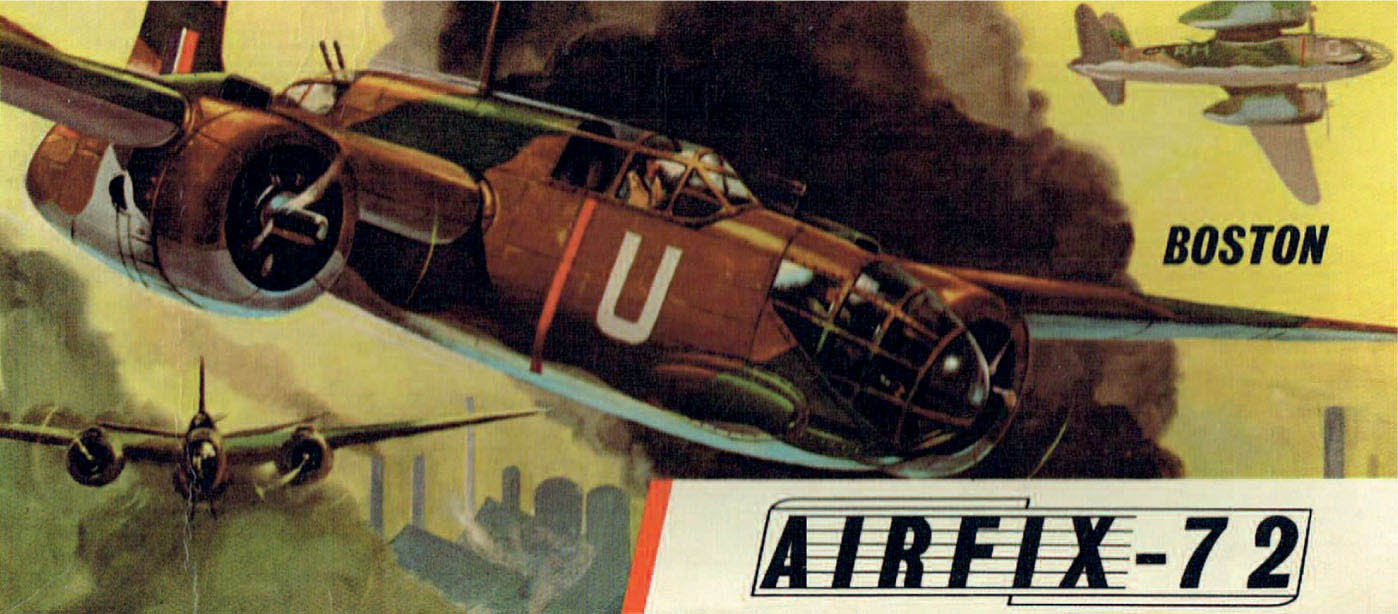
Charles Oates’ Douglas Boston III artwork on a Type 3a box, 1963.
The earliest known artist for Airfix kits was Charles Oates. He had painted many works for television and other companies, and in 1958 became art editor for the magazine Model Railways Constructor; he often used Airfix Trackside kits in his articles. I have been unable to find any surviving records of his paintings for Airfix in the archives, except for a ‘rough’ he sent in, which he hoped Airfix would use for the ‘Old Bill Bus’ released in 1966; this was subsequently painted by Roy Cross. He is generally credited with painting all, or nearly all, of the pre-Type 3 headers and box tops. He is believed to have been in poor health in the mid-1960s, which explains why Airfix was eager to employ Roy Cross.
He painted several of the Type 3 rolling-stock kits and one or two aircraft kits before Roy Cross took over. Fortunately, several of his and Howard Jarvis’ paintings are now held at the Bethnal Green ‘Museum of Childhood’ in London.
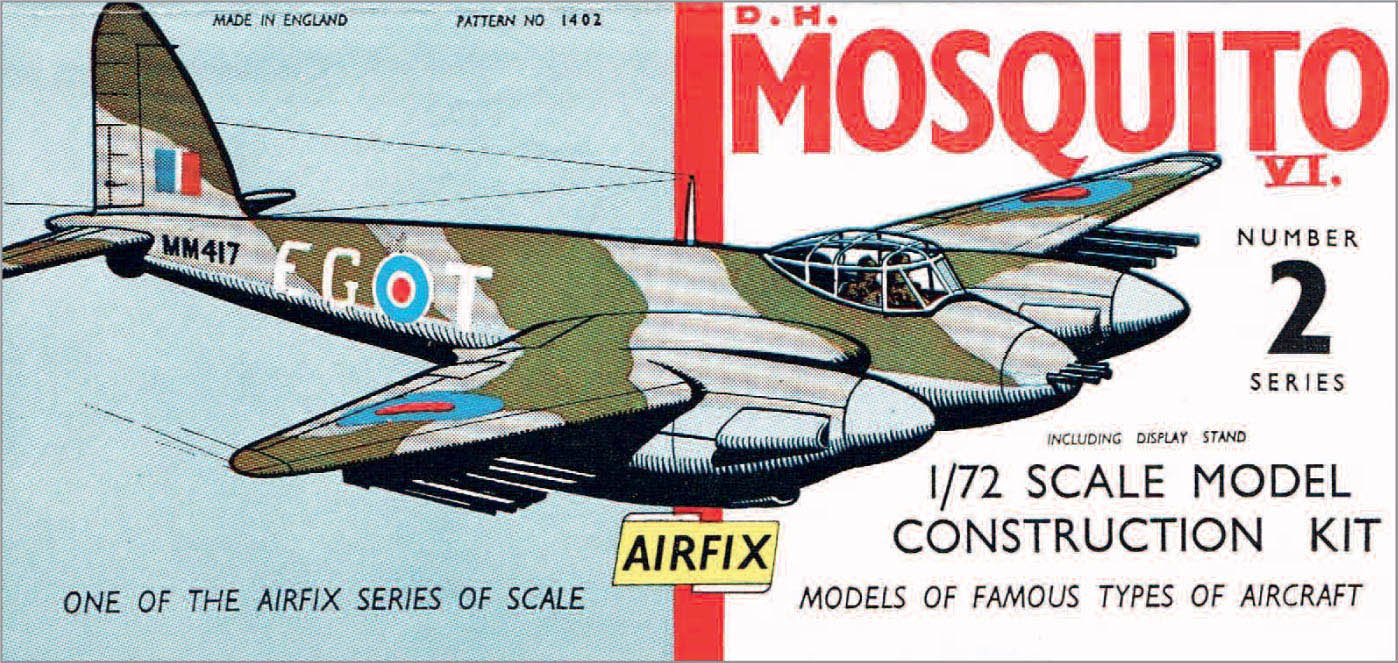
This Type 2 artwork is probably by Charles Oates.
William Howard Jarvis 1903–1964
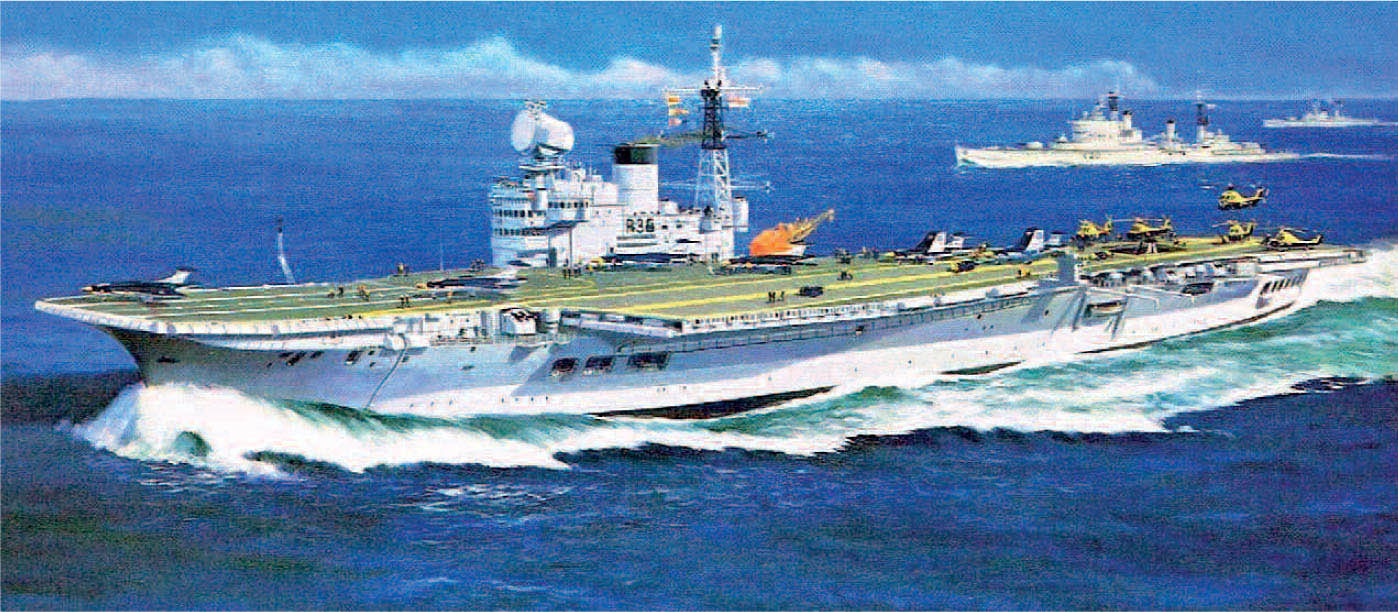
William Howard Jarvis’ HMS Victorious artwork.
William Howard Jarvis was a renowned marine artist, and painted most of the early ship kits and several Type 3 aircraft.
He was born in Liverpool on 6 February 1903. He studied at Liverpool and Naples, and trained aboard HMS Conway from 1918 to 1920. He served as a Lieutenant RNVR from 1939 to 1946. In 1953 he designed the canopy of Her Majesty’s state barge. He worked in the Walker Art Gallery, Liverpool, and Great Yarmouth Municipal Gallery, and was elected to be a member of the Royal Society of Marine Artists in 1947. (All this material is by courtesy of the RSMA’s own book A Celebration of Marine Art.)
He probably painted for Airfix from around 1963 until his death in 1964, when Roy Cross joined. The large part of the surviving original artwork from the pre-1981 period is the very early artwork that was given to the Bethnal Green ‘Museum of Childhood’ by Palitoy. These paintings formed the bulk of the pre-1981 artwork on display at RAF Hendon from June 2013 to May 2014, where many of Jarvis’ originals were displayed.
His aircraft paintings are very similar to Charles Oates’ paintings, but his ship paintings were very good. Most measured about four feet by three feet, and some of the detail was incredible. A close study of HMS Tiger reveals details of the face and uniform on the sailor standing by the front turret: this cannot, of course, be discerned on the box top, but it is good to know it is there.
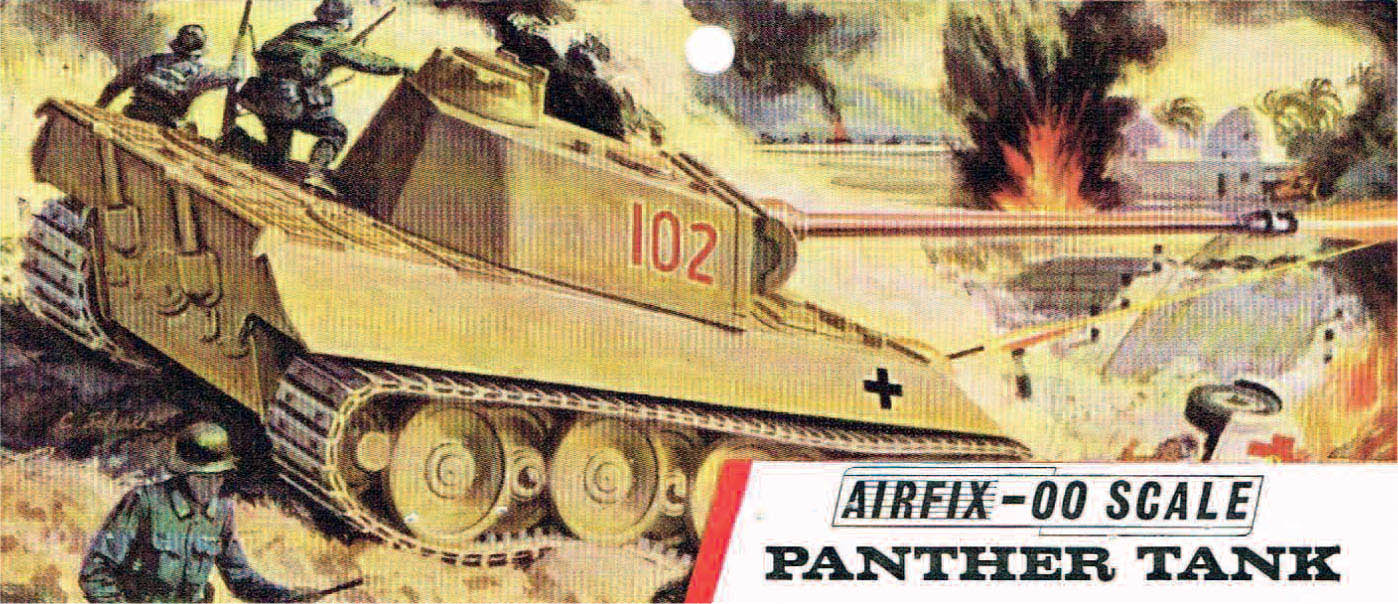
George Schule’s Panther tank artwork.
His aircraft paintings were mainly repainted by Roy Cross and later Ken McDonough, and his warship paintings were redone by Geoff Hunt. His initial large sailing ships were repainted by Brian Knight.
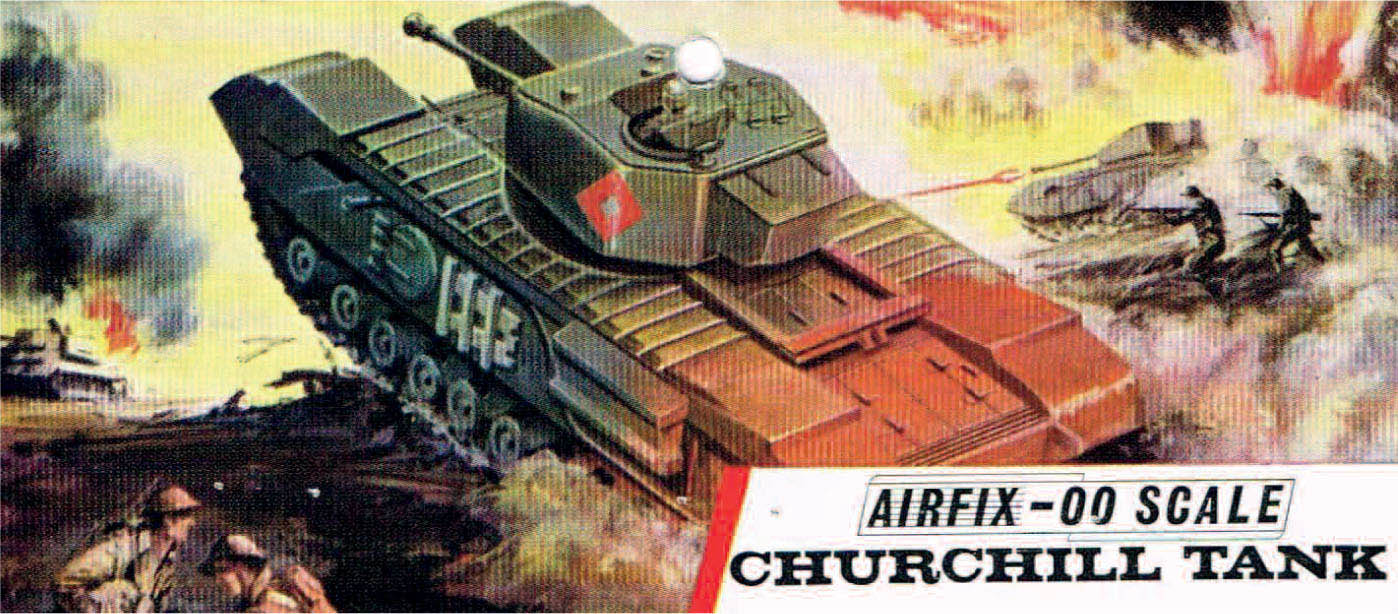
Dick Miller’s Churchill tank artwork.
In the couple of years that Roy was establishing himself and Brian Knight was joining Airfix, at least four artists were used to repaint existing box tops and headers for Type 3 releases. G. Schule’s signature appears on three of the 1:76 AFV headers – the Panther, Sherman and Assault Gun – and he possibly painted four more unsigned ones, as they are all very similar in style: the Tiger, the Bren Gun Carrier, the German Armoured Car and the Centurion Tank. The Churchill Tank, however, was painted by Dick Miller. Roy then took over painting the AFVs.

HMS Nelson, portrayed by Jack Avery.
Two ship box tops, HMS Nelson and RMS Mauretania, were painted by Jack Avery. Again, Roy took over painting the ship kits. Another artist was Andrew Prewett, who painted the first issue of the Fort playsets in 1966 and 1967, prior to Roy Cross repainting these and subsequent sets.
I cannot find any information about these four artists, and assume they were probably studio artists.
Roy Cross
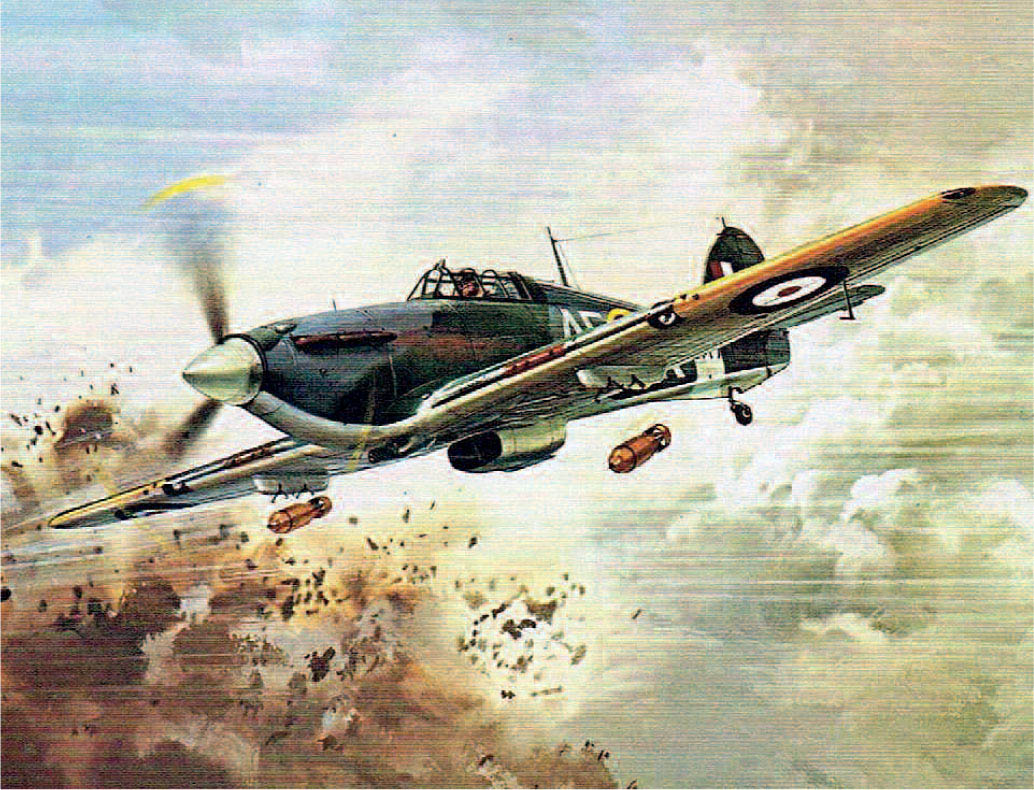
Hurricane IIb artwork from 1972, by Roy Cross.
Roy Cross’ life has been well documented by Arthur Ward in his various books. He was born in 1924, and during the war produced technical drawings for various aviation companies. In the 1950s he was a technical illustrator for Fairey Aviation, and produced ‘cutaways’ for the Eagle and Swift comics. He approached Airfix in 1964: having seen the artwork on their box tops, he was not very impressed by it, and felt he could do better. The two incumbent artists were in poor health and Airfix liked the quality of his artwork, so he was quickly signed up. The first painting he did for Airfix was the Dornier Do 217E-2 for a Type 3 release in 1964, and for the next ten years he painted the majority of Airfix box tops, the remaining ones being painted by Brian Knight.
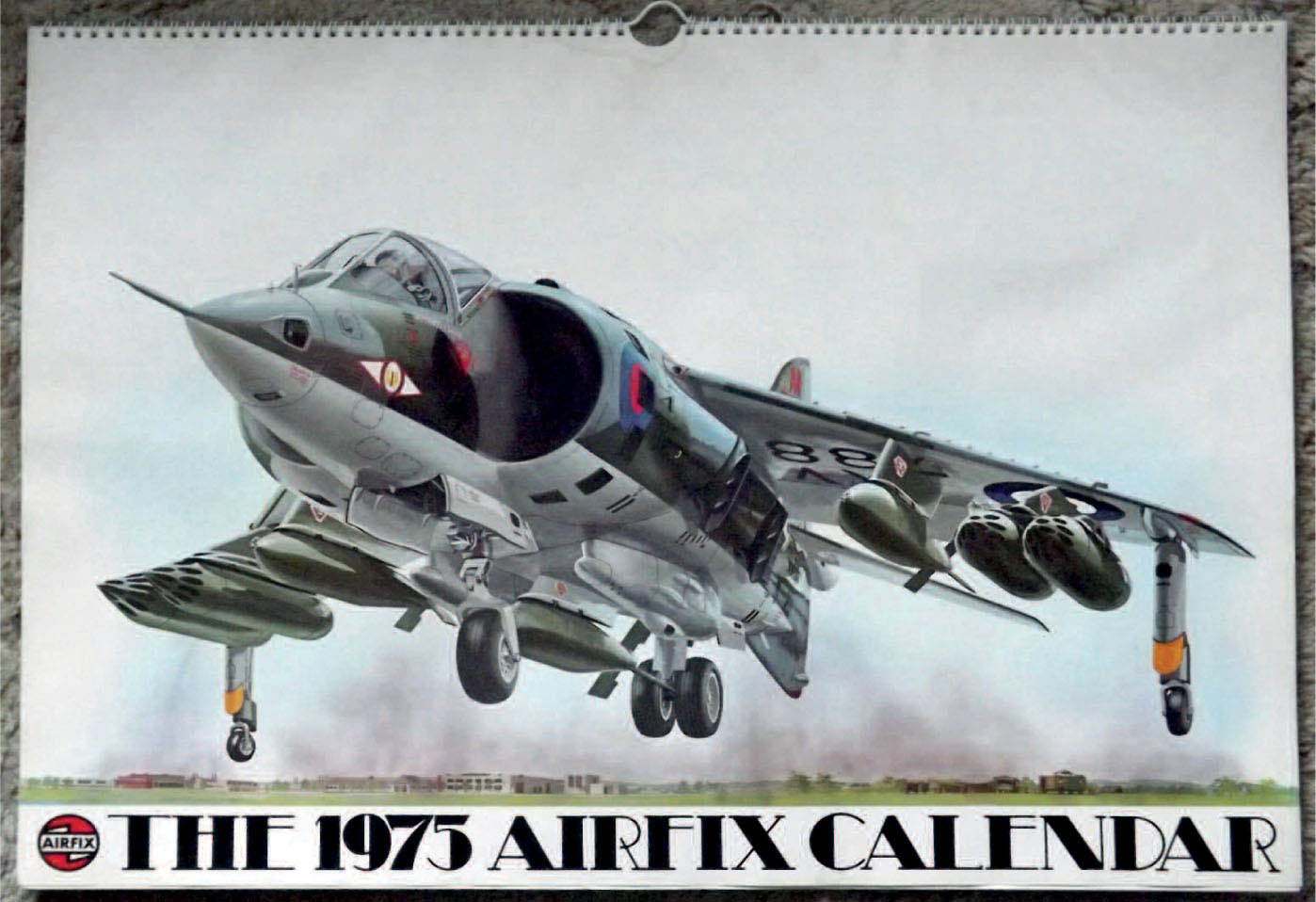
The 1975 Airfix calendar, mostly illustrated by Roy Cross.
Roy’s paintings were mainly done in gouache and were smaller than the previous artwork. However, the detail was incredible. He managed to capture the shape of the subject, apply panel lines and rivets, and add a suitably detailed background. The great majority of modellers, if asked which box tops encouraged them the most to buy the kits, will say that it was those with the brilliant paintings of Roy Cross.
The paintings were generally painted in a rectangle that was almost square, but the subject would have to fit into the ‘letter-box’ shape of the box top or header. Roy found this ‘letterbox’ constraint annoying, but he always managed to deliver the goods: the Fokker Dr.1, for example, fitted perfectly. It was only much later that we were able to see the rest of the painting that had been excluded by the ‘letterbox’ dimension.
Roy would be supplied with copies of technical drawings by Airfix, as well as a pre-production kit that he could assemble and then ‘pose’ for his initial drawings. He usually submitted two or three pencil ‘roughs’ to John Gray, who then returned them with ‘No’ or ‘Yes, this one’ written on them. He would then prepare a colour rough with a clear overlay showing the box-top shape, and when that was approved, painted the final artwork. One or two kits, such as the 1:24 Mustang and Harrier, actually featured a second final painting rather than the one shown in the catalogue, but all the rest used his final artwork.
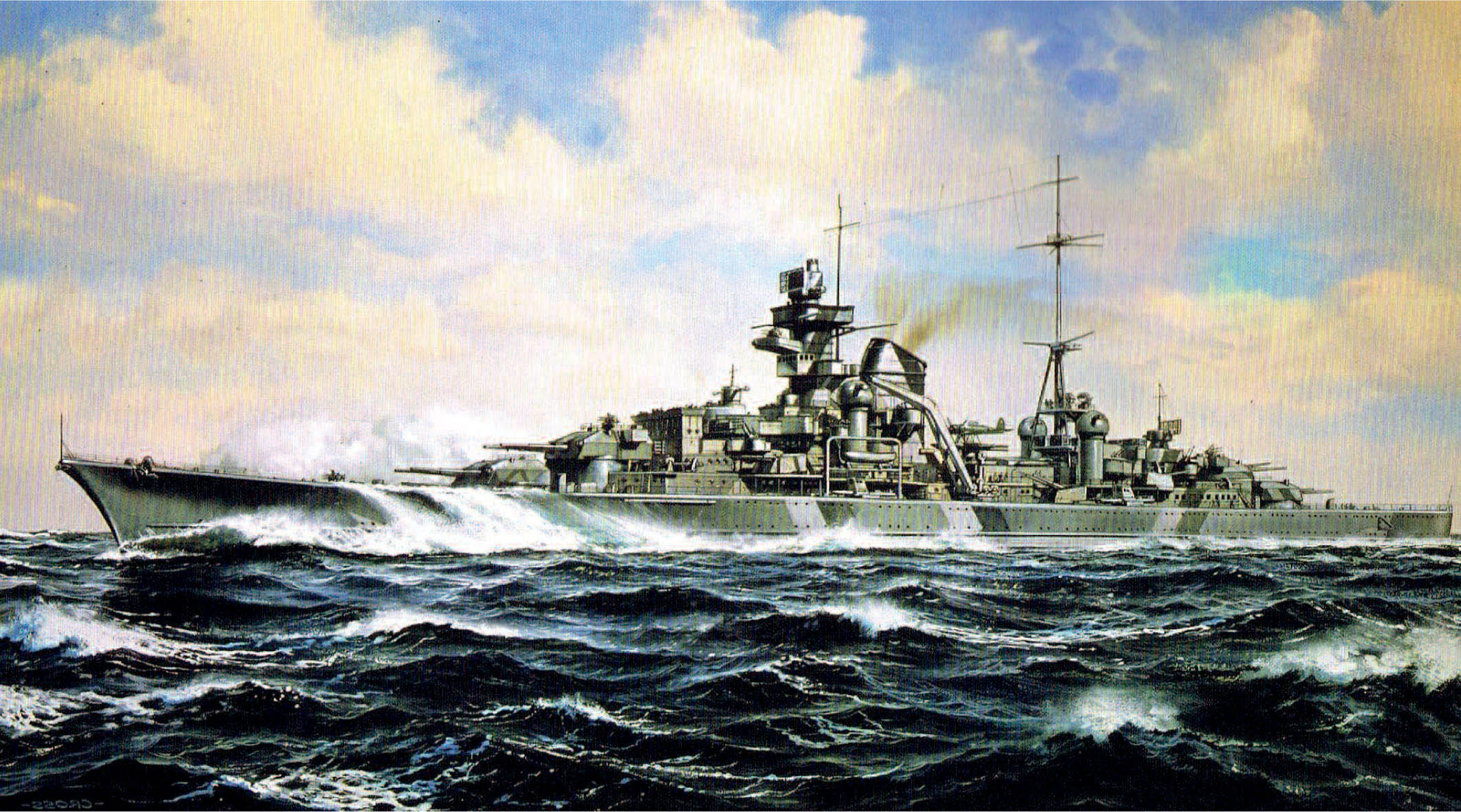
Roy Cross’ final ship artwork for Airfix: 1975’s Prinz Eugen.
Roy and Brian would both take their completed artworks to Airfix. These were immediately sent to the photographic studio where they were photographed on to transparencies for ongoing use. Usually three photos were taken: one for the box top, the second for the box sides and ends, and a third for use in the catalogue. The original artwork was then carefully stored. Any alterations, such as the removal of any violent action, were made using the transparencies, often by other artists.
Roy’s tenure at Airfix was the period of greatest consistency, with Brian Knight painting the sailing ships and figure sets and Roy painting everything else. Most of the memorable artwork comes from this period. His fine painting of the Lancaster coming in to land with an engine on fire was so popular that in 2005 Humbrol released a model of ‘G for George’ just so the painting could be used!
By 1974 the workload was tailing off, and Roy left Airfix to pursue his career as a marine artist. His final paintings for Airfix were for the A300B Airbus and Prinz Eugen kits. Before he left, he recommended Ken McDonough as his replacement.
There has been much speculation over the years about the fate of the original artwork, everything from the paintings being thrown into skips to them lying on the factory floor and being walked on! Peter Allen states that all the kit artwork was successfully transferred to Palitoy’s offices in Coalville, Leicester, in 1981. It seems that the bulk of the artwork went missing in the period between General Mills announcing it was to sell Airfix and Humbrol buying Airfix in 1986.
Peter Allen, who had left Palitoy by then, offered to travel up to Hull, unpaid, for a weekend to supervise the transfer of the Airfix archive. Unfortunately Humbrol refused his generous offer, and consequently it has not been possible to say what actually went to Humbrol!
Peter says that Palitoy considered all the playforts and polytanks to be ‘toys’ and ordered the artwork for them to be dumped in skips. Peter managed to save several, and these were recently sold at auction. The moulds for all these playforts did, however, remain at Palitoy and are today much used by Hornby!
This is probably the origin of the rumour about artwork being thrown out. Apart from the early artwork given to the Bethnal Green Toy Museum by Palitoy, the whereabouts of only half-a-dozen Roy Cross originals, at most, are known. The owner of one of these paintings states that when Palitoy was clearing out the offices in Coalville, the staff and employees of associated companies were offered anything from a waste bin to a painting for a fiver (£5); not surprisingly he chose to spend his £5 on a Roy Cross original rather than a stapler or an office chair! Whether all the rest went that way cannot be confirmed, but it is surprising that more artwork has not reappeared over the last thirty years. It is likely that senior employees may have been given several artworks, but again this cannot be confirmed.
Fortunately all the artwork was still stored on transparencies, and it is the transparencies that are used to this day for any box tops or catalogues. Having been through the transparency files I can confirm that Airfix has all but a dozen or so of Roy’s and Brian’s paintings in this format. In Roy’s books about his Airfix artwork, the most recent being published in 2014, the vast majority of the paintings reproduced therein came from transparencies kindly loaned by Airfix. The Humbrol artwork is largely intact but is also, sensibly, recorded on transparencies. The modern digital artwork is, of course, stored on computer.
Brian Knight, 1926–2007
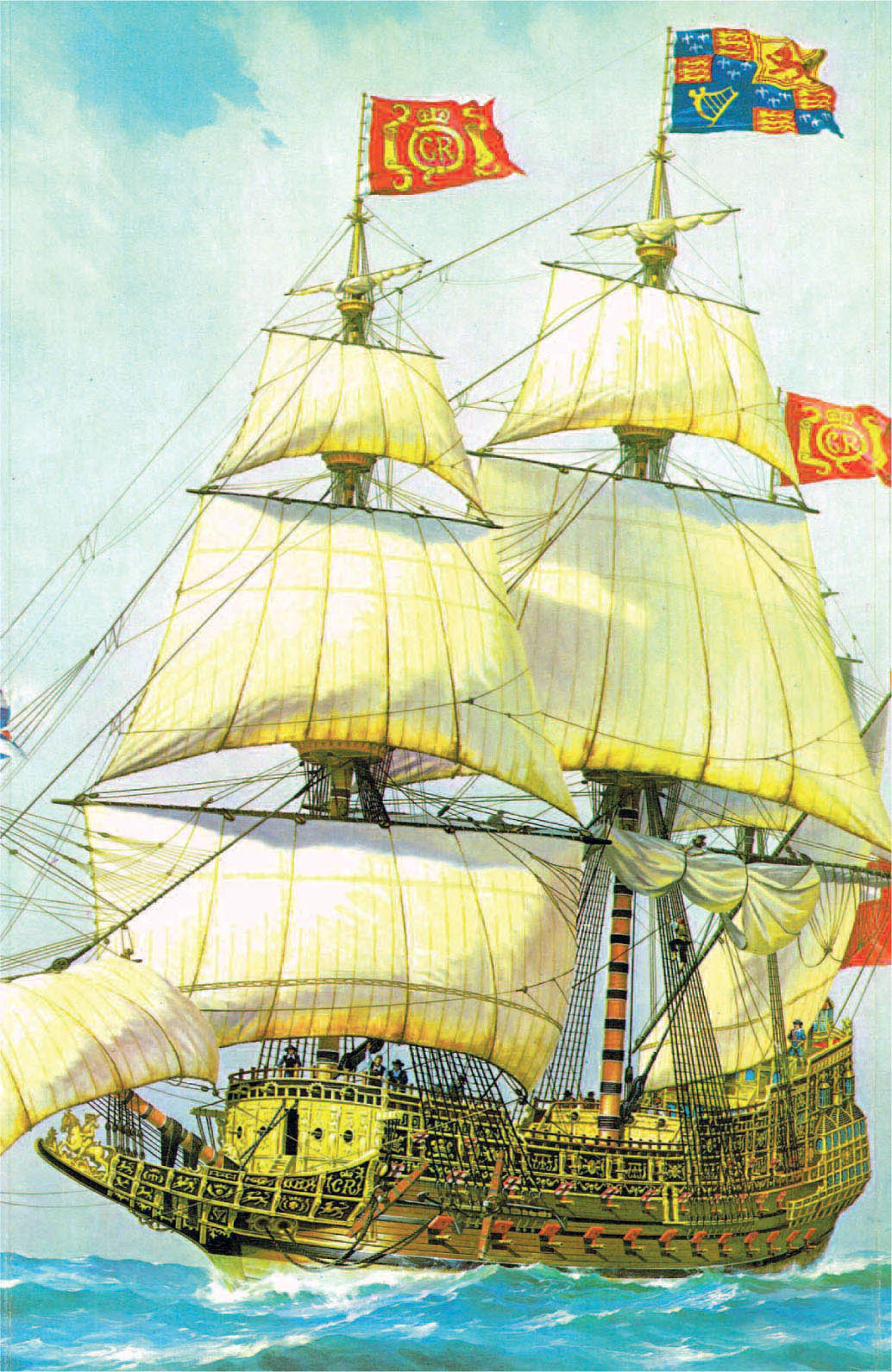
Brian Knight’s impressive Royal Sovereign artwork.
Brian Knight had been painting pictures for Revell and FROG for some years, when he came to the attention of Airfix. Following the death of William Howard Jarvis, Airfix had a need for a sailing ship artist and Brian was asked to repaint the Endeavour. With the exception of the Great Western, painted by Roy Cross, he painted all the other large sailing ships, the final one being the St Louis in 1972. The two later ships were painted by Geoff Hunt.
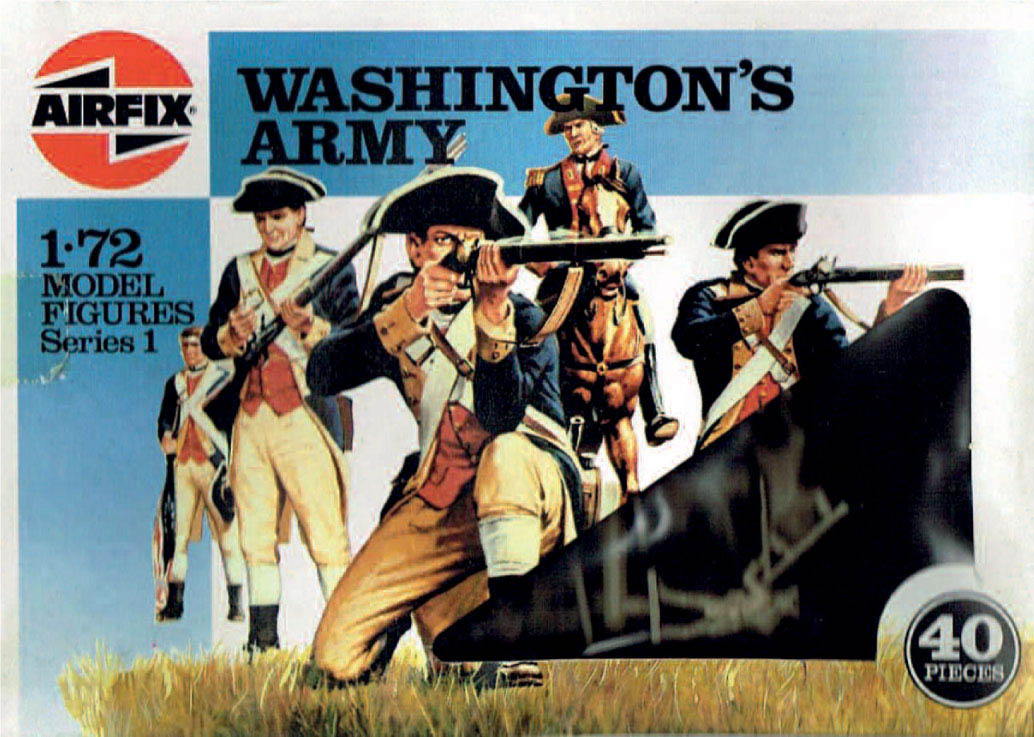
‘Washington’s Army’ artwork by Brian Knight.
For a couple of years after Type 3 was introduced, Airfix continued to produce its OO/HO figures in Type 2 boxes, but wanted to put them into Type 3 boxes with full-colour paintings. They were also just starting to produce the 1:32 scale range of figures. Since the sailing ships were only being released at a rate of one a year, Brian was hardly overworked and he was approached and asked whether he was any good at painting figures; Roy had never been keen on painting figures. He produced ‘roughs’ for the Bedouin Arabs and British Paratroops to replace the existing Type 2 paintings in use, and promptly got the job. He then repainted all the earlier box tops and, from the 1968 World War I Royal Horse Artillery, he painted all the new boxtops as they were released. His last OO/HO painting was probably the Waterloo British Cavalry released in 1972.
He also painted all the early 1:32 figure sets up to the Afrika Korps in 1972. In 1972, Bill Stallion was producing the artwork for the new OO/HO and 1:32 releases, so it is likely that Brian left Airfix around that time.
Sadly he died in 2007, having suffered from Parkinson’s disease.
William H. (Bill) Stallion, 1925–2008
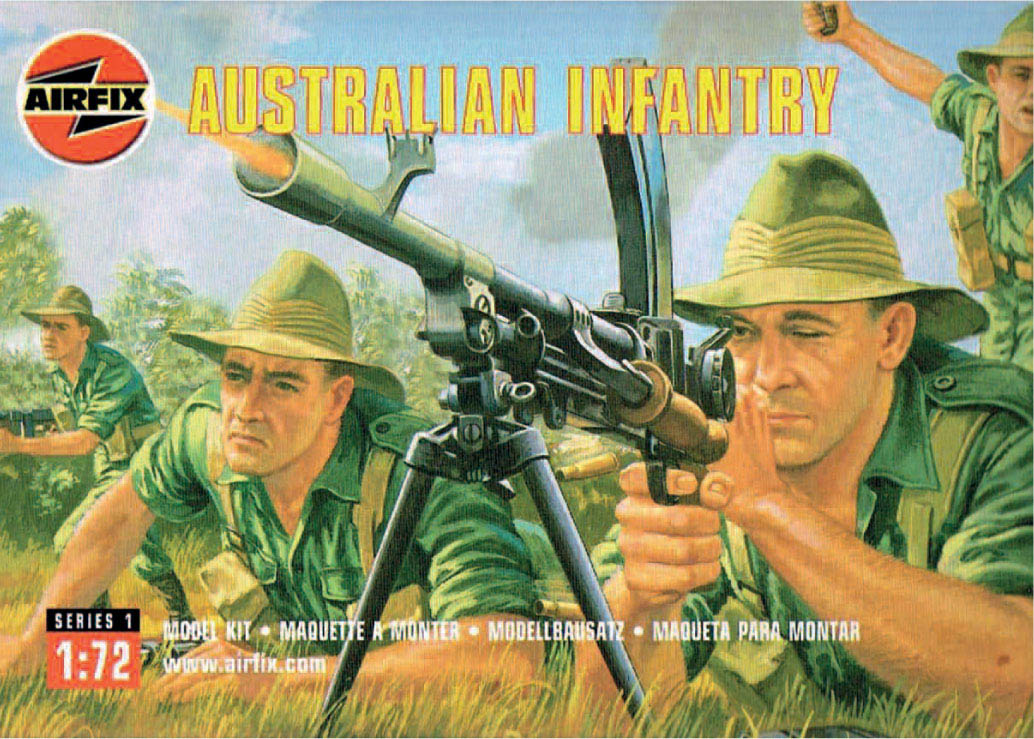
Australian Infantry artwork from 2003, by Bill Stallion.
Brian Knight had been successfully painting box tops for Airfix figures for several years, and it had been assumed that he painted all the figure sets. However, it recently became clear that the later ones and the multipose sets were painted by a hitherto unknown artist, whose style was similar to Brian Knight’s: hence the confusion. Following the publication of his book The Boys’ Book of Airfix in 2009, Arthur Ward was contacted by the son of Bill Stallion, who had painted many of the 1970s figure sets, as he had recognized his father’s face from the multipose Eighth Army box top included in the book!
Arthur interviewed Bill’s widow and wrote the following biography for his ‘Collecting Friends’ website and his most recent book The Other Side of Airfix, which he allowed me to reproduce in Constant Scale No. 44 in 2011. I am indebted to Arthur for his permission to reproduce it in this book:
As a young man Londoner, Bill Stallion joined the prestigious 6th Airborne Division, serving as a wireless operator in Palestine during World War II. After demob he missed out on the ex-serviceman’s grant and ended up working in a brewery. However, he had always been interested in drawing, and found that living in Brixton it was possible to combine evening classes at London’s prestigious Slade School of Art.
Before long Bill had the confidence to embark on a career as a freelance commercial artist, and approached agent Dick Browning, who quickly took him on. Bill’s chosen vocation was that of a figure artist. Dick Browning also represented well known design team Negus-Sharland, who were well known for their advertising art. They designed some very famous posters for BOAC and also created notable stamp designs for the British Post Office, together with a wide range of other highly regarded designs. It seems that Dick Browning procured similar commissions for Bill Stallion, who soon became proficient at illustrating press ads and posters for companies producing everything from radios to toiletries.
Bill’s wife Edna told me that he was pretty adept at amending his artwork to suit different international markets, changing the racial characteristics of foreground figures to suit the requirements of domestic consumers in China, Africa or Asia, whilst retaining the key product details.
Whilst he was scouting for new business in the early 1970s, Dick Browning discovered that Airfix, then at its height and producing a dazzling array of new kits and model soldiers each month, was keen to add more freelance illustrators to its roster. Consequently Browning managed to get Bill on Airfix’s books, and from a period starting around 1972 up until the end of that decade, kept his client very busy indeed. By this time Bill and Edna had moved to Sussex and started a family.
A figure artist, Bill naturally specialized in illustrating the boxes for Airfix soldiers – mostly for their soft plastic 1:32 scale figures (many of the famous ‘Target Boxes’ are Bill’s) but also for Airfix’s 1:32-scale figure kits – all of the multipose range, and many from the 54mm Collectors Series.
Interestingly Bill, who worked alone from his studio in his home in Southwater, near Horsham in Sussex, was forced to cast himself as the subject of many of his paintings. I was shown a selection of surviving Polaroids, self-portraits, taken by Bill or his wife Edna, showing him frozen in the classic poses so familiar to Airfix fans.
When the subject was carrying a firearm, which most soldiers were, of course, Bill would fashion a German MP42 sub-machine gun or a Browning .303 SMLE, for example, from offcuts of wood or broomstick handles.
The most obvious self-portrait of Bill can be seen in the box art of the Multipose British 8th Army set. He is the figure in the foreground bursting through coils of enemy wire with his bayonet fixed. To accurately portray the musculature on a figure’s legs, and the Desert Rats for example, Bill wore short trousers, or had to be photographed in his underpants!
Bill realized that questions might be asked at Haldane Place if Airfix were presented with box art which repeatedly featured an all-too-familiar face, so to avoid using himself as the model for the model as it were, he enlisted the assistance of his neighbour Steve Brown, a pilot with BEA. I was told of many occasions when curtains twitched in adjacent houses and when other neighbours relaxing in their gardens became aware of two grown men, often carrying prop weapons and wearing makeshift helmets, apparently fighting in the garden of Mr and Mrs Stallion. The couple’s children, Greg, Mike, Kate and Helen, soon grew used to such behaviour!
It is because Bill Stallion dealt exclusively via an agent that he has remained anonymous. Airfix’s relationship was only with Dick Browning. Furthermore it is only in recent years that when they can, in appreciation of the work of Roy Cross, for example, Airfix have added artist signatures to box art.
In fact as every Airfix enthusiast knows, it is very difficult to be precisely sure about the provenance of a great deal of vintage Airfix art. Fortunately because Bill’s daughter Helen, herself a professional picture researcher and familiar with the intricacies of the media world, got in touch with my publisher, Ebury Press, that her father will earn his rightful place in that hallowed list of Airfix Artists.
In a second interview Arthur records how Bill went on to a successful artistic career in the British film industry. I have managed to find the signature ‘Stallion’ on only one transparency so far, and it was his daughter Helen who kindly supplied me with a list of her father’s artwork.
Ken McDonough, 1921–2002
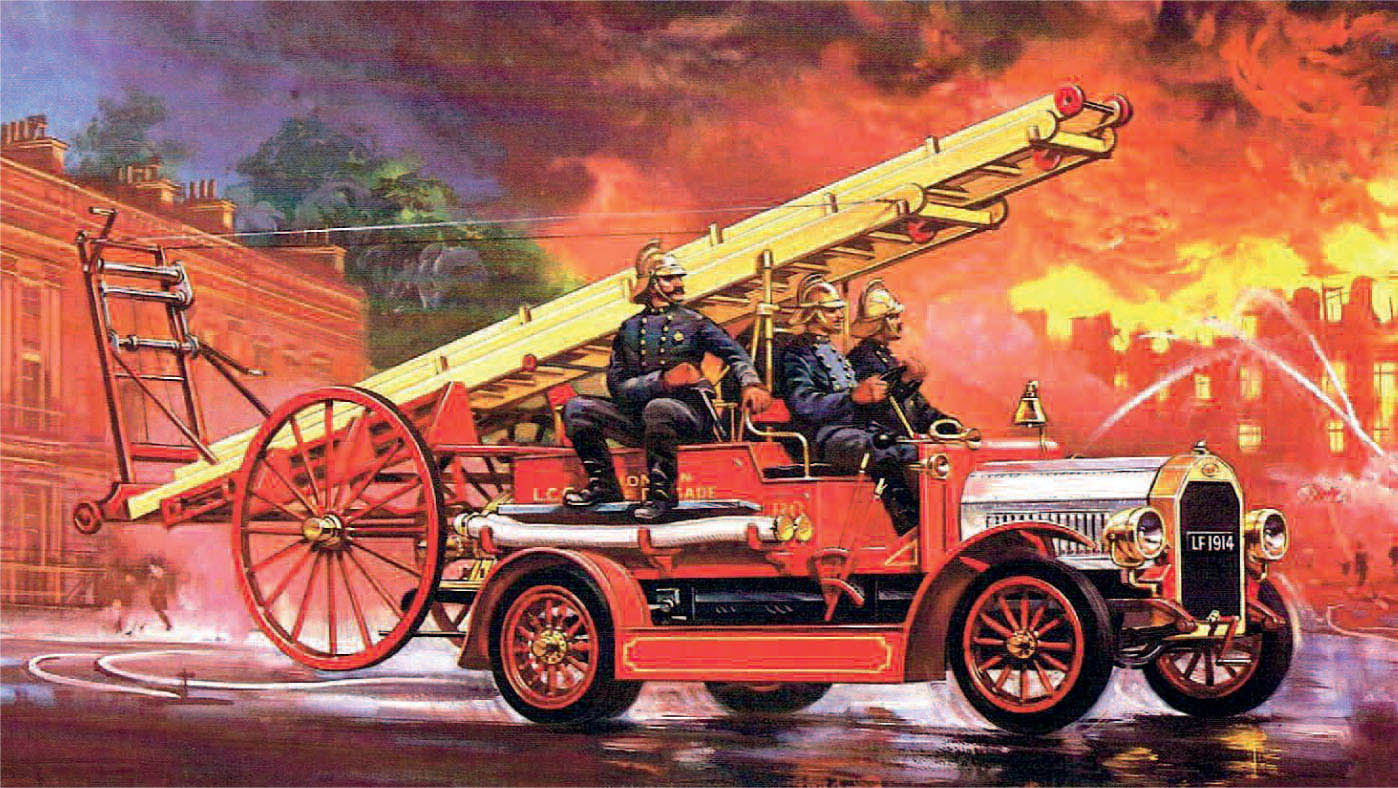
Fire engine artwork by Ken McDonough.
Ken McDonough, who died in 2002 aged eighty, was recommended to Airfix by Roy Cross when he retired. For the remainder of the 1970s he was the principal artist at Airfix, with the figures being painted by Bill Stallion.
His artwork style was very similar to Roy Cross’ artwork, although to the seasoned eye it was possible to see the differences. He painted the two 1:32-scale Lee and Grant tanks as well as repainting a couple of the small ones. He produced a stirring picture of the German E-Boat, and his masterpiece is probably the 1:24 Stuka. Geoff Hunt would take over the painting of ship subjects.
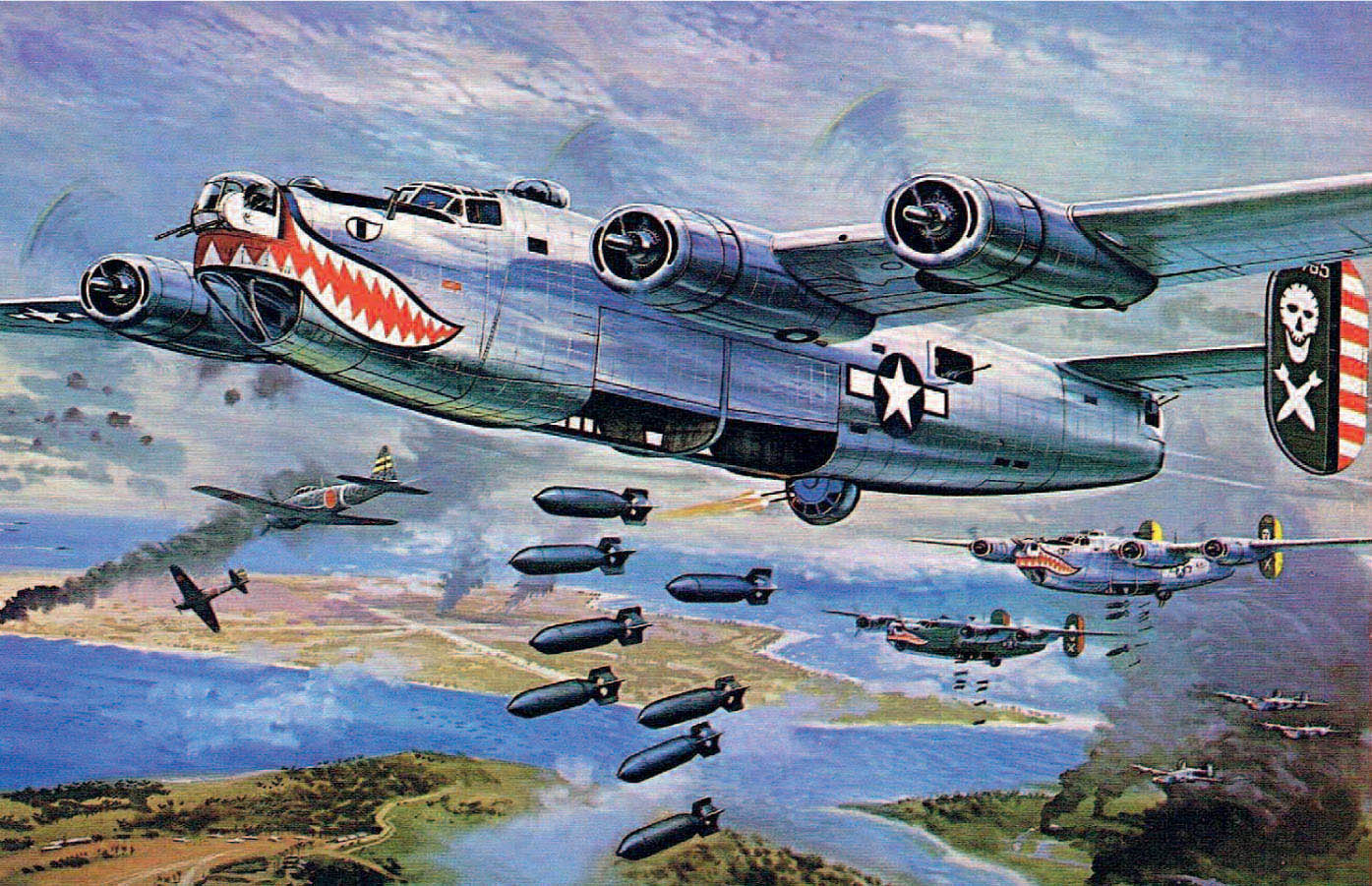
Consolidated Liberator artwork by Ken McDonough.
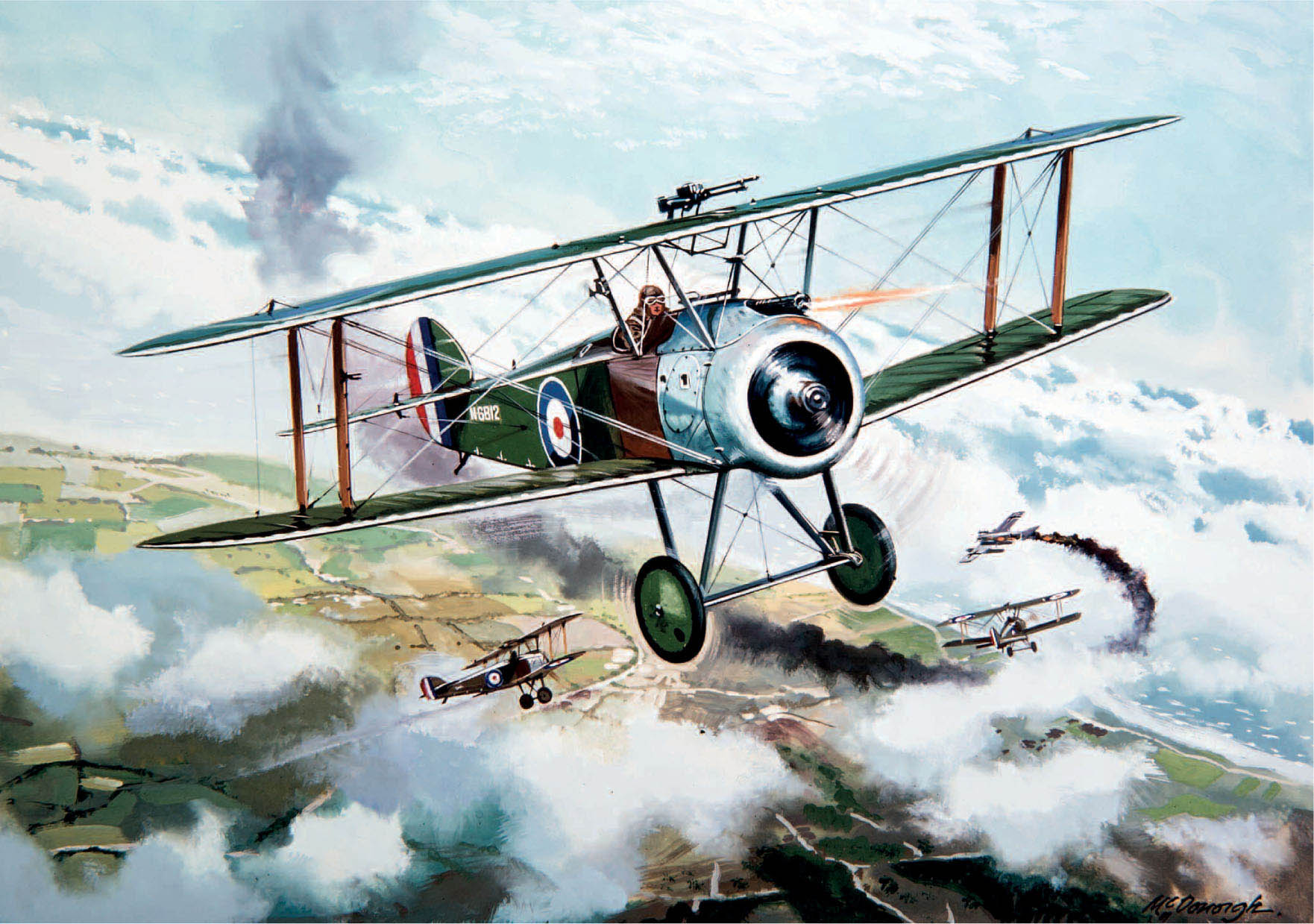
Ken McDonough’s Sopwith Camel artwork. AIRFIX
Mainly he concentrated on aircraft and finished off the repainting of the early Type 3 box tops, including the Lightning F.1a, Hunter, Liberator, Halifax and Catalina. In 1979, when Airfix introduced its ‘New Squadron’ programme of kit rotation, a lot of aircraft needed new artwork, most of which Ken would complete. However, several aircraft were repainted by another new artist, Ron Jobson.
Geoff Hunt

HMS Warspite artwork by Geoff Hunt.
Following the departure of Roy Cross and Brian Knight, Geoff Hunt was commissioned to paint the 1:600 warship kits. He worked for Airfix until around 1980, but recently he painted the Mary Rose for the Mary Rose Trust, and his painting features on the 2014 Mary Rose kit release. He told his story of his connection with Airfix in Constant Scale No. 53 in 2014:
Even as a child I was fascinated by ships, and was always drawing pictures of them. One of my artist heroes was Roy Cross, whose work I followed avidly, first when he was one of the illustrators for Eagle comic – of which I still have many, including Roy’s absolutely incomparable double-spread cutaway paintings – then when he worked as the artist for Airfix, of course, and later still as a ‘proper’ marine artist. When I was growing up, Eagle comic and Airfix box-tops were my art galleries: I learned so much about how to paint and visualize from them. My own career followed a somewhat similar course to Roy’s, though to begin with I trained not as a technical artist but as a graphic designer and illustrator.
My first box-top illustrations were not for Airfix but for Frog kits, then part of the Lines Brothers/Tri-ang group at Margate. Having first written to introduce myself, I went down to show them some specimen ship paintings, on the strength of which they commissioned me to do two box tops, HMS Exeter and HMS Revenge. This would have been in about 1975. As it turned out, Frog kits were nearly at an end, and these were the last two ships they ever produced. But arising from that I got a great deal of other business from Margate, working on brands such as Tri-ang Trains, Minic Ships, and much else; while the experience with the box tops gave me an opportunity to approach Airfix, then based not far from me in Wandsworth.
I can’t remember how I had discovered that Roy had finished working for them.
However, I went along to see Jack Armitage, and he commissioned me to work on the 1/600 ships. I think the first subject I worked on may have been HMS Warspite; certainly it was one of the early subjects as far as I was concerned, and I remember it very well for the enormous difficulty I had in getting a sketch approved – I know I did at least fifteen alternative sketches. But no other subject ever gave me, or them, the same amount of trouble.
Over the period 1976 to 1979 I painted all the ship box tops that were issued, after which there was a break because my wife and I sold up house, bought a boat, and went sailing for a year. But we came home for a time in the middle of that period, and in that time – February/March 1980 – Airfix came up with a further two 1/600 ships, HMS King George V and HMS Repulse, for which I did the box tops. There were to be no more British World War II ships – the last one I remember Airfix considering in research would have been the cruiser HMS Sheffield – but there was one more really epic 1/600 ship, the USS Forrestal.
Finally, as far as I was concerned, there was one more square-rigger, the Bounty, and then the 1/72 RAF rescue launch. At this point Airfix, as I had known it, changed out of all recognition, with little requirement for new box tops, and for the next ten years or so I devoted much of my energy to illustrating book jackets, the highlight of which was the whole series of Patrick O’Brian novels. Like Roy, I became a member of the Royal Society of Marine Artists, and in 2003 its president. Since 2008 I have formed a very close association with the Mary Rose Trust, and the new kit painting was done originally for them.
Geoff’s only foray into non-maritime artwork was his painting of the T-34 tank for a late 1970s release. Although nowadays he is best known as the artist for the Patrick O’Brian novels, Geoff retains an affection for his Airfix artwork.
Ron Jobson
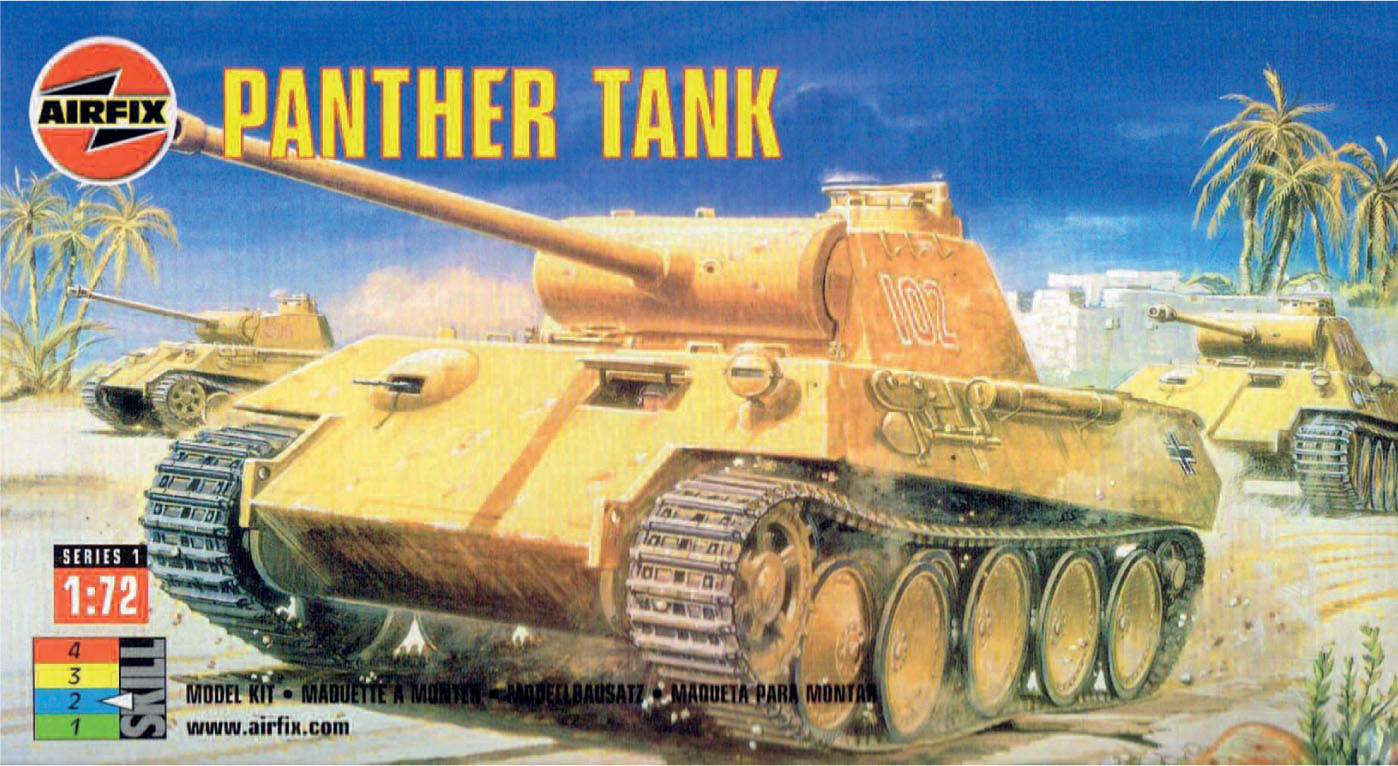
Panther tank, by Ron Jobson.
Ron Jobson was born in Brixton and won a scholarship at thirteen to the Camberwell School of Arts and Crafts, where he studied for three years until the outbreak of war in 1939. He then worked in Fleet Street doing work for wartime magazines and Ministry of Information propaganda. After the war he produced artwork for Sci-Fi magazines and later Matchbox toys and Airfix kits.
He was probably employed through a studio in the late 1970s. His aviation artwork was very similar to Roy Cross and Ken McDonough’s in its execution.
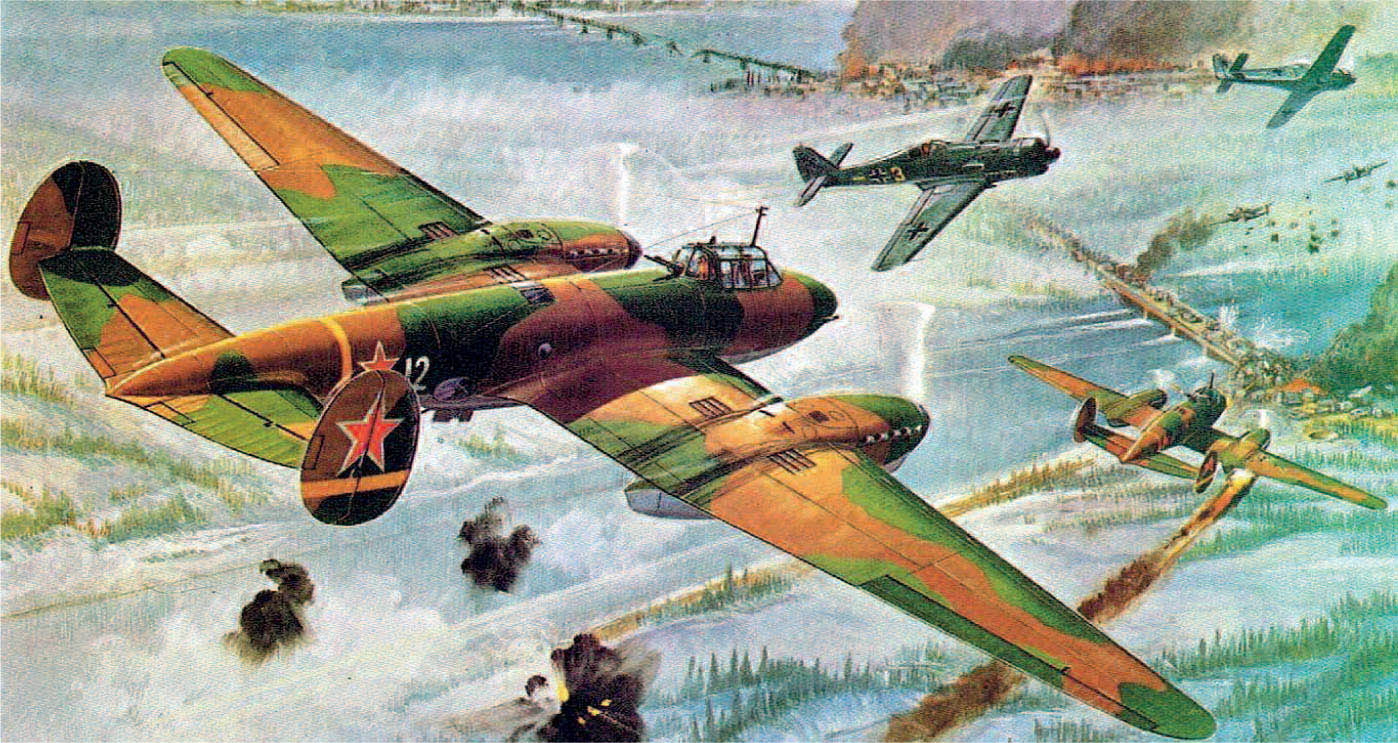
Ron Jobson’s Petlyakov Pe-2 artwork.
He repainted the Panther and Churchill tanks, and for their ‘New Squadron’ releases he repainted the P-47, Avenger, Pe-2 and Il-28. The aircraft were particularly fine paintings and it was a pity he did not do more, as his aircraft paintings come closest to those painted by Roy Cross.
Another artist who repainted a few of the early tanks for 1979 releases was Jeremy Banks. He painted the Bren Gun Carrier and probably the Sherman and Assault Gun, although these are unsigned.
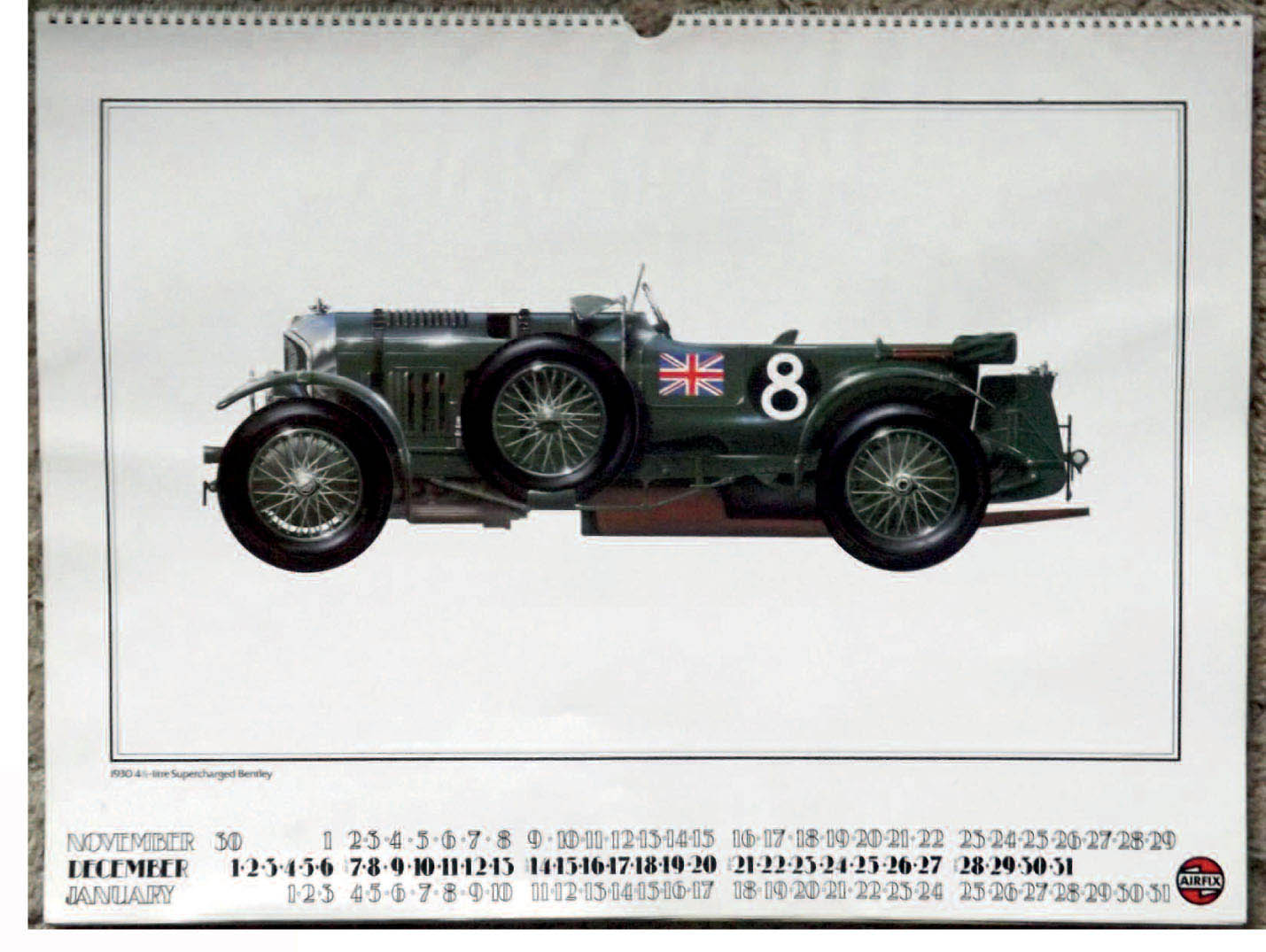
Bentley artwork by Stephen Hipwell.
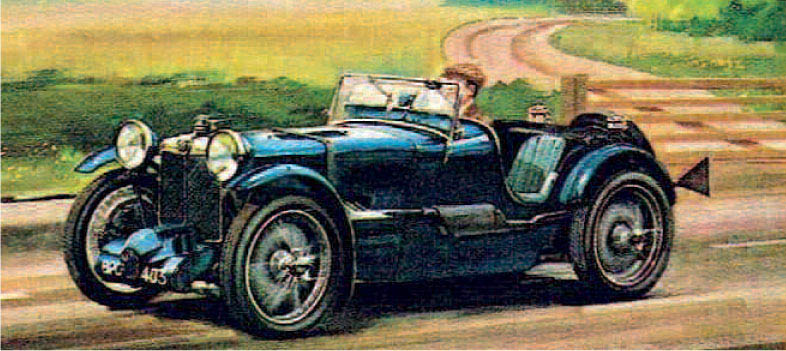
James Dugdde’s MG Magnette artwork.
The large Crusader Tank painting has the signature of Harrison on it, and he also painted the Bugatti 35B box top. A single artist was Stephen Hipwell, who painted the first box top for the 1:12 Bentley, which was used in the 1975 calendar. Likewise Roy Huxley, who painted a lot of Matchbox kit box tops, painted the Porsche 917 for Airfix. The MG Magnette was painted by a James Dugdde.
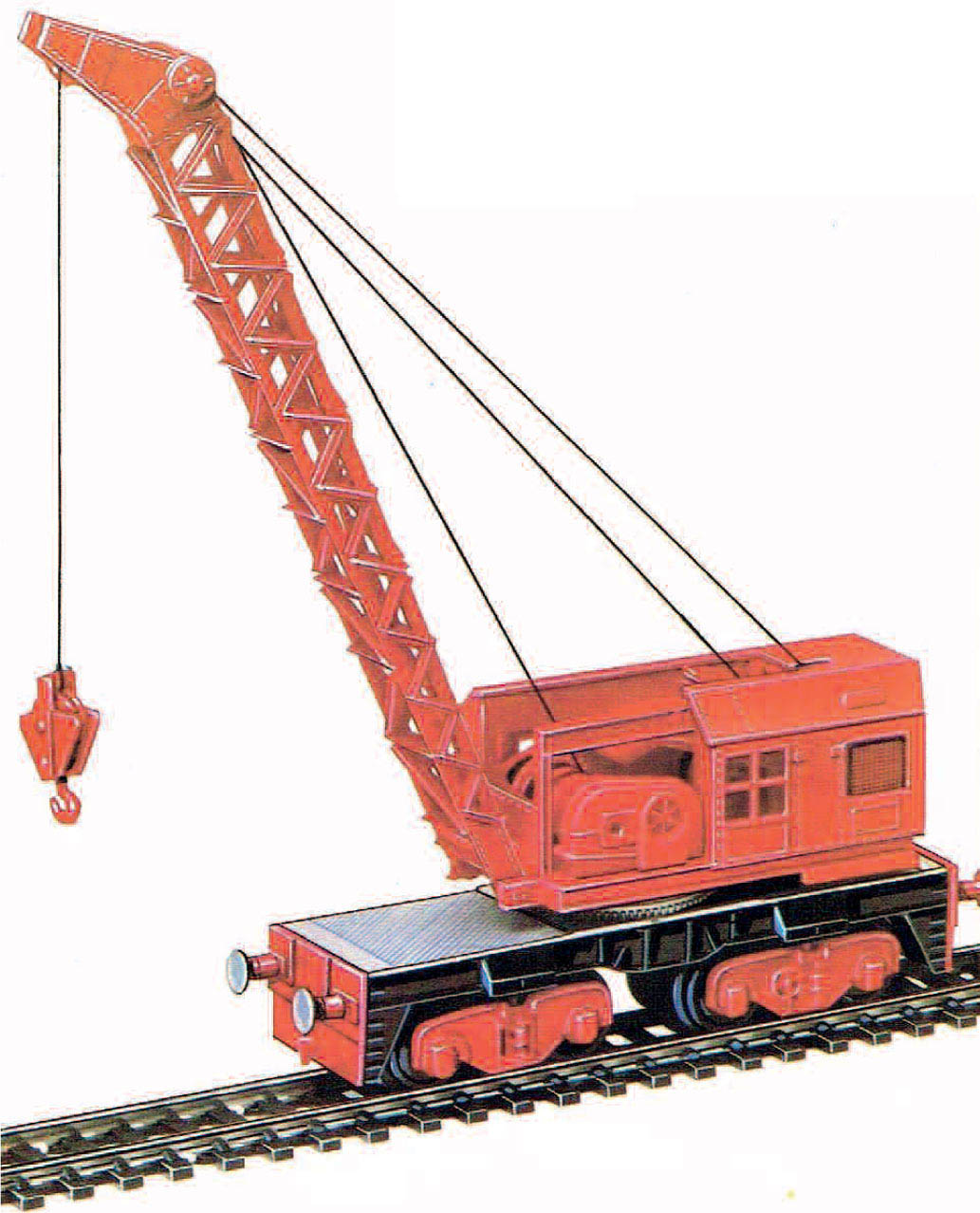
15-Ton Diesel Hydraulic Crane artwork, by Cliff and Wendy Meadway.
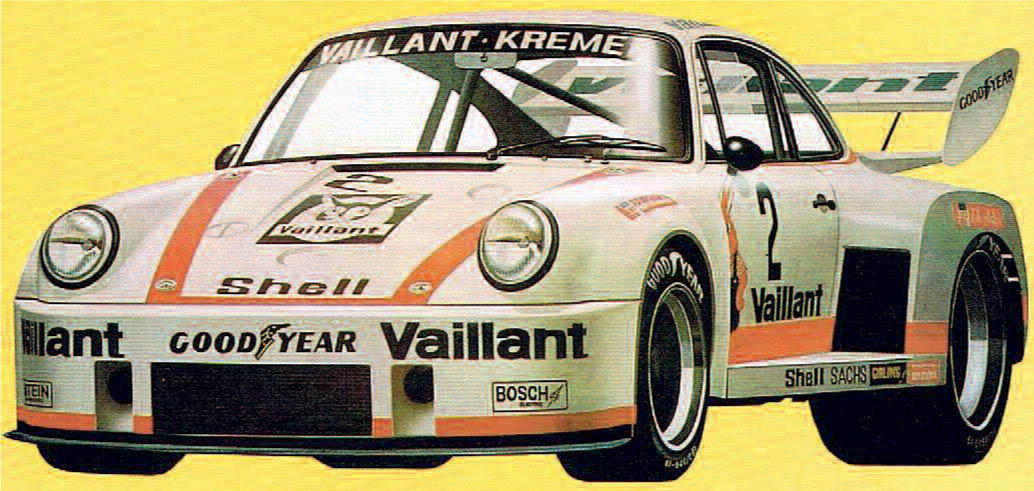
John Barber’s Porsche 934-5 artwork from 1979.
The robins were painted by John Barber, and he possibly painted the other birds, but this cannot be confirmed at present. He also painted the box tops for some of the Japanese car kits Airfix bought in the late 1970s. Apparently Airfix did not buy the artwork, but were given several boxes to copy. The rolling stock paintings that appear in the trains catalogues were by husband and wife team, Cliff and Wendy Meadway.
Most did not paint for Airfix again after its rescue from bankruptcy in 1981. One who did was Mike Renwick, who painted the 1:48 Mosquito, and then for Humbrol painted the Swedish Bristol Bulldog and DH Heron.
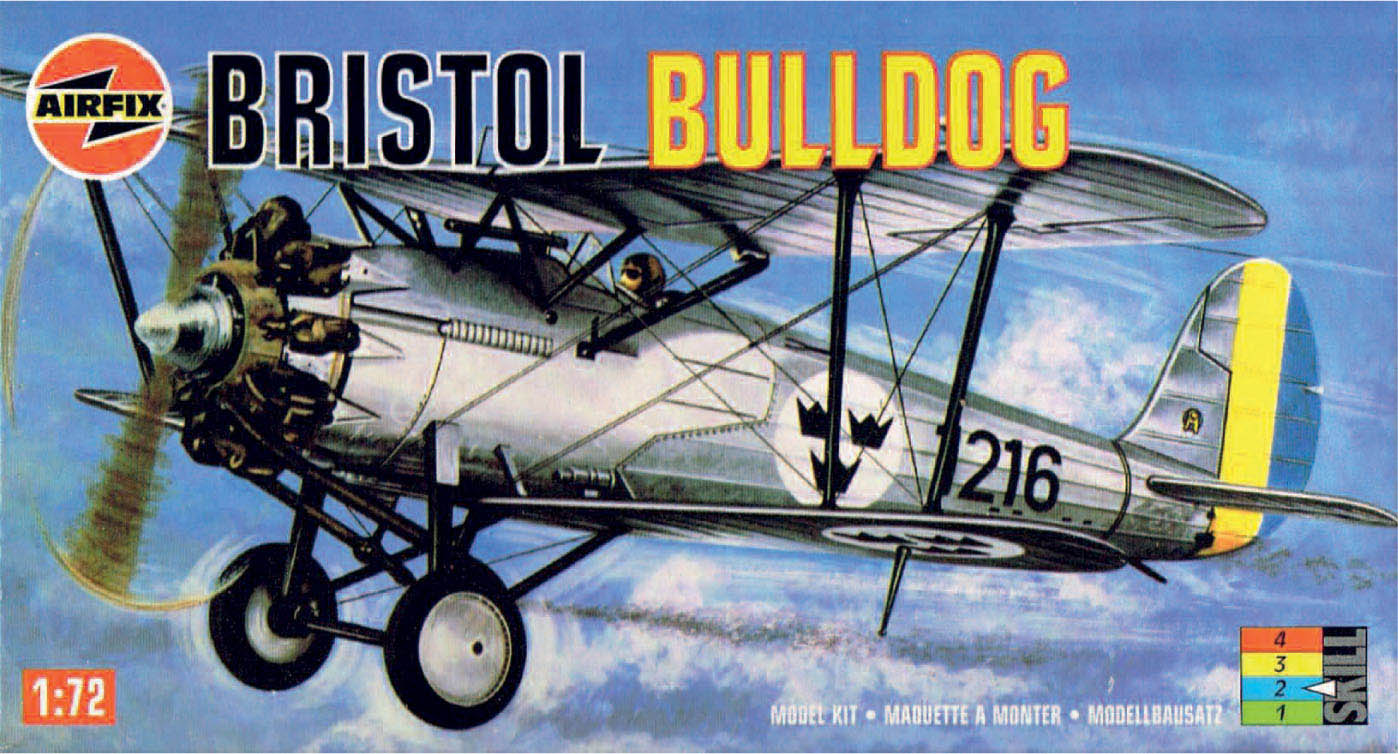
Mike Renwick’s Bristol Bulldog artwork on a Type 11 box.
Post-1981 Artists
Following the rescue of Airfix in mid-1981, Palitoy was using the photo boxes, and there was less need for new artwork. Those kits that did require paintings either used the existing artwork or, in the case of the MPC kits, the US artwork tended to be used.
Initially Humbrol used art studios who provided artists, but later they employed the likes of Gavin McLeod and John D. Jones.
Paul Monteagle
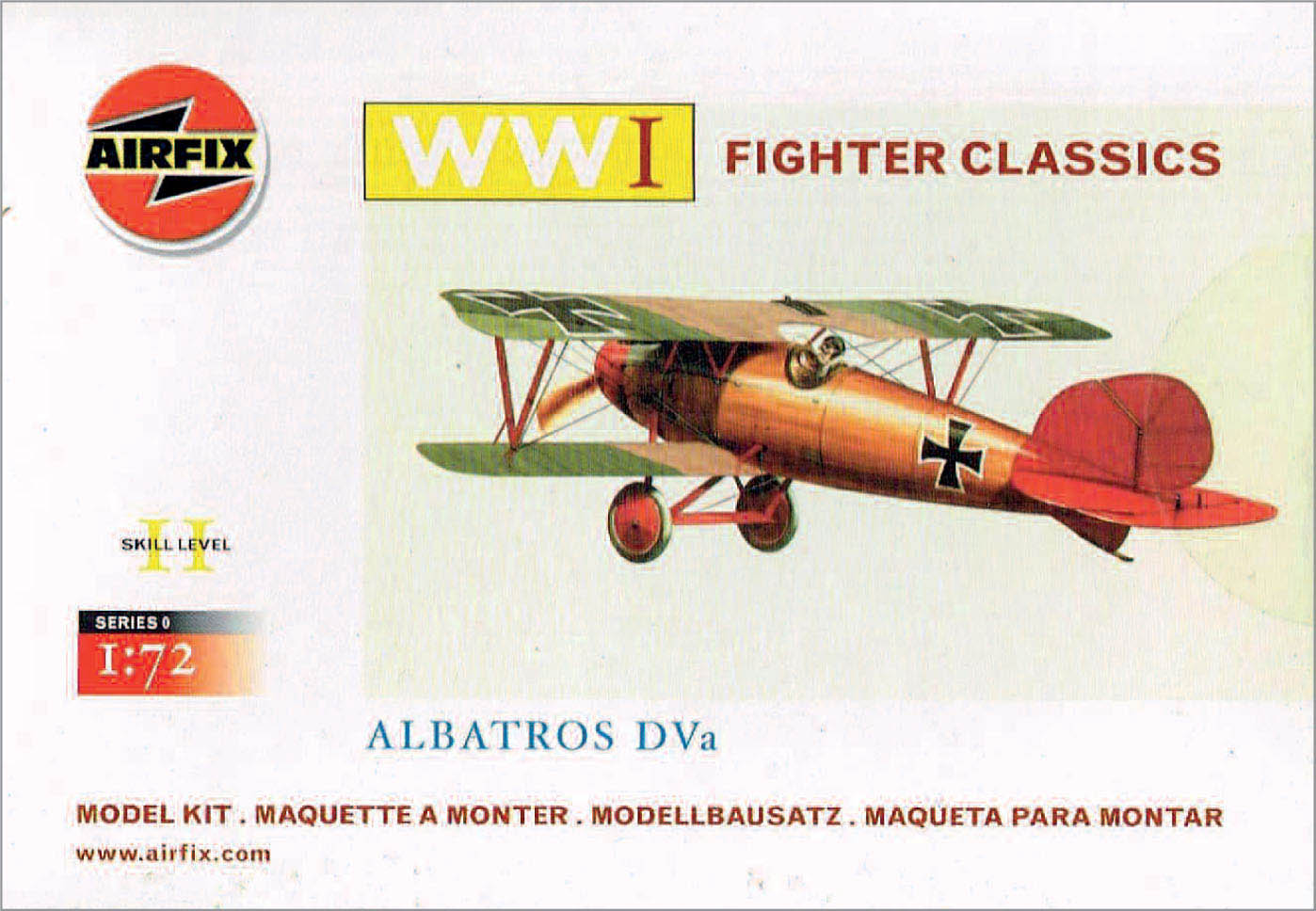
Paul Monteagle’s Albatros DVa artwork.
Shortly after purchasing Airfix, Humbrol employed the talents of several new artists. One was Paul Monteagle who was active around the late 1980s to early 1990s. I made contact with him after I noticed his signature on a painting of kittens on a lap tray I was using, and he gave this account of his time with Airfix in Constant Scale No. 48 in 2013:
I have always had a passion for Airfix. In Tadcaster, North Yorkshire, where I was brought up, Airfix was all we had. I recently built a 1:48 Grumman Widgeon (Paul still models for pleasure – ed.). Why, because of fond memories of my Airfix one built when I was about eight or nine. In fact if you look at most of my builds in 1:48 and 1:35, they all equate to Airfix subjects. It is almost as if that if Airfix didn’t produce it in the 1960s it wasn’t used in World War I and World War II!
I have most 1980s catalogues as I patched and pasted them as well as worked out the layouts, which is how I met Jeff Robinson and came to do the box art. Unfortunately they were ‘art’ directed and not done how I would have liked. I even did the stegosaurus. If you look at page 36 in the 1989 catalogue you may notice it doesn’t have an artwork: that is because Jeff realized the ‘tranny’ and original painting were missing, and I had twenty-four hours to produce an outcome for the printer who needed to proceed.
I did all the Historic Cars’ (pp. 32–33) and Vintage Aircraft series (pp. 26–27) at that time, again all in the 1989 catalogue. Sometimes the deadline was so tight I was told to ‘copy’ existing box art, as they owned copyright – kind of early computer art, I guess. The boxes that I originated fully like the Spad and Pup (p. 27), and I think all the cars, I still quite like but wished I could have done backgrounds. I also painted the portraits in the ‘ovals’.
I am an Airfix fan more than any other large kit name. I also did a 1:32 Fokker DVII for Revell-Monogram for the American market, which is on my website, as is other commercial work.
As you (editor) mentioned, I have also done cats and now horses (a new venture), but I love aircraft and I am still a modeller. I did have a regular column in Scale Models International magazine for a while (till family and work got in the way), which started in April 1996 with my Blue Max box-art painting on the cover, showing I think what I could have produced for Airfix had I been given ‘full rein’!
I have just secured early retirement from full-time teaching and hope to do more book covers for Ray and Angie at Albatros, where I am currently doing a datafile cover for early Avros. Also Colin at ‘Freight Dog’ (who owns the Blue Max range now) has asked me to produce a cover art, so maybe the story isn’t over yet, except for Airfix? Trevor Snowden offered me the 1:24 Mosquito – my dream job, but I had to say no because Hornby insist now that all artwork is computer generated.
As a postscript I would like to add that I was once at the nationals and a certain Mr Cross was there signing books. I joined the queue. Without looking up he asked me what name he should make it out to. I politely said, ‘Paul, and can I thank you’. ‘Why?’ he said – and I replied ‘Because of you I have painted all my life.’ ‘I have heard that before,’ he replied. ‘What do you do’? ‘Well I do quite a few data files for Albatros.’ ‘Are you Paul Monteagle’? Well, I was on cloud 9: my hero knew who I was! Now, he must have known Brian Knight who did the other volumes, and I wasn’t him, still he knew me and I was (still am) made up with that!
As a further postscript I would like to say that I haven’t anything left from those days except for a couple of black-and-white photos of the models of 1:32 cars to help me produce the paintings. I was upset that the ‘art’ director wouldn’t let me paint skies for the aircraft as he wanted the same blue colour for all of them, which resulted in awful and badly done cutouts around the paintings. I didn’t do the airliners (which were copies of the Roy Cross artwork – editor), just World War I aircraft and the cars, plus the stegosaurus that I think had my name on. I haven’t kept a copy.
Fortunately Airfix did keep his original stegosaurus painting, which I found in the Artwork Archive.
It is ironic that for the 1990s releases, the cars had a rather lack-lustre background added. Paul’s official website is found at www.paulmonteagle.com
James Goulding
James Goulding sadly died in 2010, but from the mid-1980s to around 1990 he painted many of the Humbrol releases. Humbrol was gradually returning the aircraft kits to the catalogue, many with new decals and markings, so they required new artwork. Being an aircraft illustrator he was well suited to the task, and had actually previously painted for Airfix, doing the box top for the 1980 Avro Lancaster.
He is recorded at Airfix as working for the ‘Spearhead’ Design Studio, and several paintings are attributed to Spearhead but clearly resemble his style. Along with Anthony Sturgess he painted many of the World War II Aircraft of the Aces series, as well as several other re-released aircraft.
He repainted Roy Cross’ Spitfire IX, JE-J, and his Hurricane Mk IIb. He painted the much updated HS Buccaneer S.2B, and prepared an artwork for the unfinished Goshawk kit. He painted most of the new and reissued aircraft of the late 1980s.
His style was quite distinctive, and one can easily identify his box tops. Amongst the larger scales he repainted the 1:48 Hawker Fury I and the 1:24 Messerschmitt Bf 109E.
He appears to have finished painting for Airfix around 1990.

Messerschmitt Bf 109E artwork for the ‘Aircraft of the Aces’ series by Anthony Sturgess.
Anthony Sturgess
Anthony Sturgess may have been a studio artist; he was certainly a contemporary of James Goulding, and he painted roughly half of the World War II ‘Aircraft of the Aces’ series. He repainted the Dornier Do 217J in a style more like a ‘rough’. His ‘Aces’ aircraft were of a much finer style and far better than his Dornier. He also painted the modified Mil Mi-24 Hind A/D for a 1988 release.
As with James Goulding, he does not appear to have painted for Airfix after about 1990.
Terry Harrison
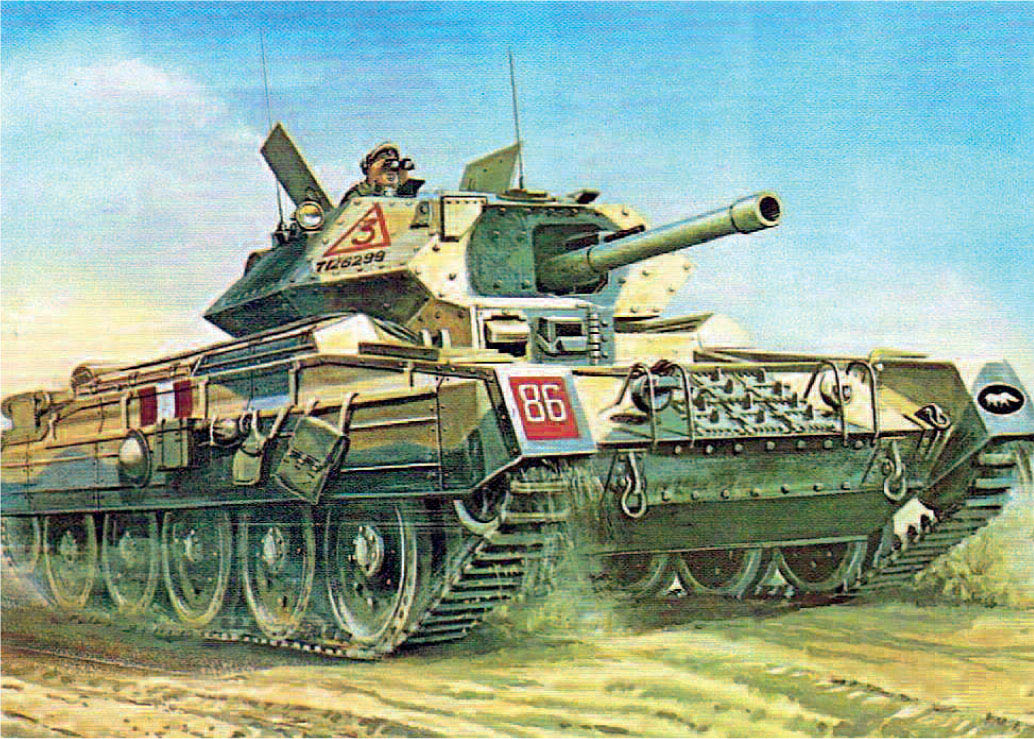
Crusader III tank artwork, Terry Harrison.
Terry Harrison is now a successful painter of landscapes. In 1988 he painted the updated Lynx HAS.3 for a Type 9 release. His signature is identical to the ‘Harrison’ on the 1975 Crusader Tank and Bugatti 35B, so he is almost certainly the same artist.
The Humbrol Fire, 1989
In 1989, Humbrol suffered a serious fire in a warehouse at Hull. Many kits, including supplies of Arthur Ward’s Model World of Airfix book and kit combination, were destroyed. It is understood that some of the artwork was damaged by the water used to extinguish the fire. As part of the insurance settlement, Airfix was required to have several artworks repainted.
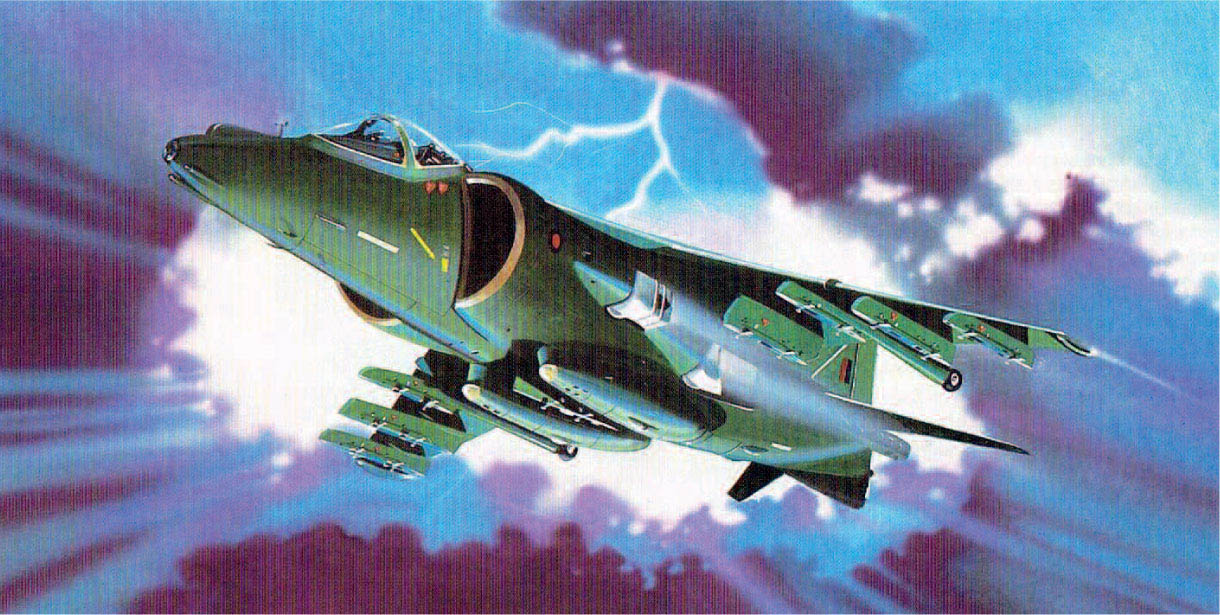
Doug Gray’s Harrier GR.7 artwork.
This does seem a strange exercise, since some of the repainted artwork was never used. Others, such as the Wellington and Sunderland were repainted, in a darker style, by Doug Gray. Gavin McLeod re-did the Me 262 and several others. Gavin would go on to become Airfix’s in-house artist until his death in 2003. The repainted pictures were basically copies of the Roy Cross artwork, but minus the background detail for which Roy was well known.
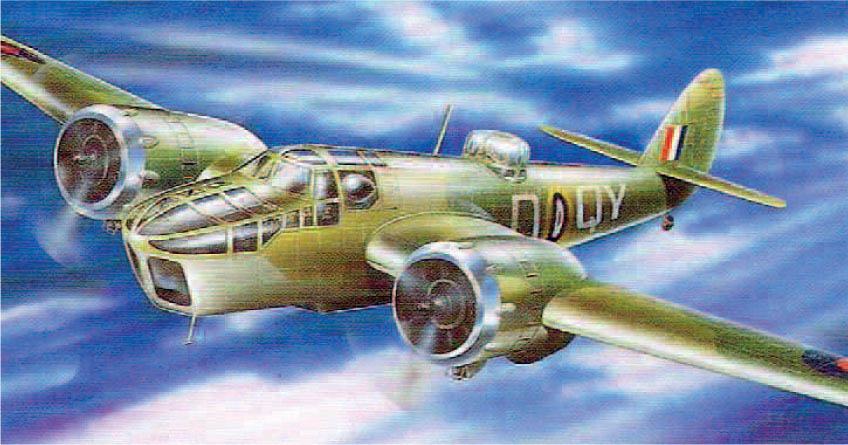
John Wallis’ Bristol Blenheim IV artwork.
In the early 1990s Airfix re-released, at short notice, three German aircraft, the Hs126, Fw189 and He 111, and these were painted by D. Hubert and John Wallis; they were rather lacklustre paintings which did little to encourage the buyer to part with his money. John Wallis also repainted the Bf 109G-6 boxtop, which was used for many years.
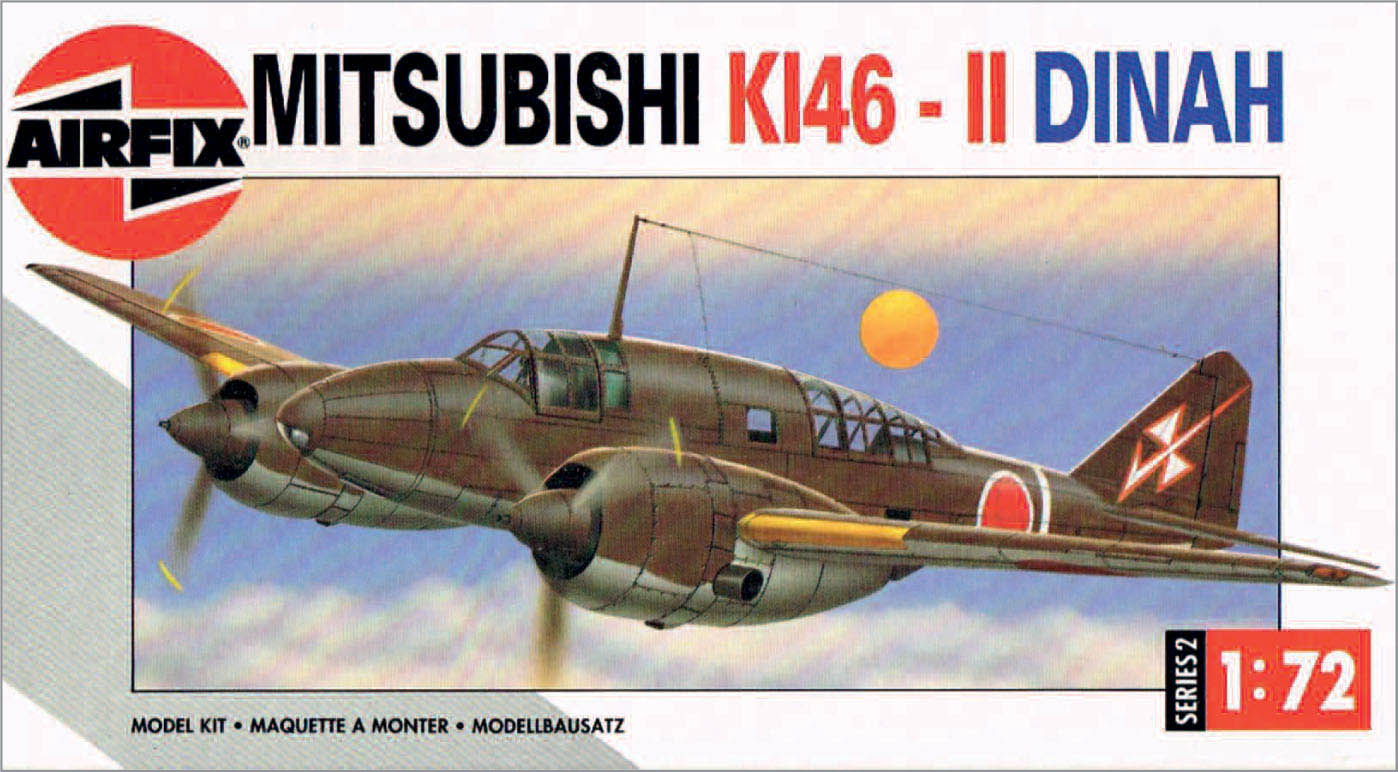
Serge Jamois’ Mitsubishi KI46-II Dinah artwork.
Airfix was now working closely with Heller, and some Heller artists would be used by Airfix. The 1:48 Buccaneer S.2D/ SMk50, Grumman Duck and Avenger were painted by Serge Jamois, who also painted the 1994 Coastal Defence Fort set. The Gun Emplacement was painted by Adrien, another Heller artist?
Gavin McLeod, 1951–2003
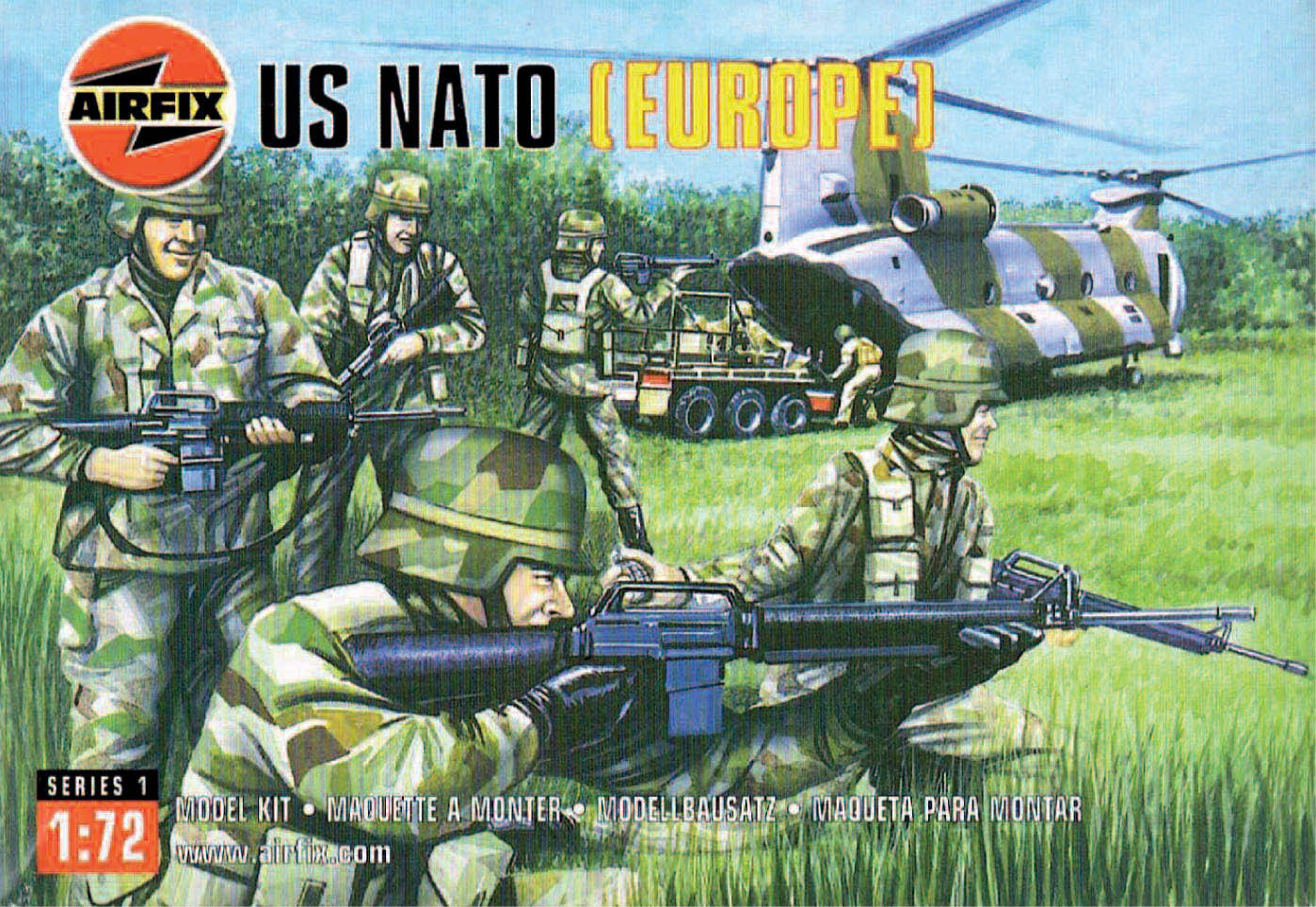
Gavin McLeod’s Modern US NATO Troops artwork.
Gavin McLeod was contacted by Humbrol following the fire of 1989 to repaint some of the damaged artwork. He was employed by Airfix from then until his untimely death in 2003. He is best remembered for his beautiful airbrushed artwork, which featured on most of the box tops in this period; his B-17, Navy Lynx HAM.8 and Mosquito NF. XIX are particular favourites of mine.
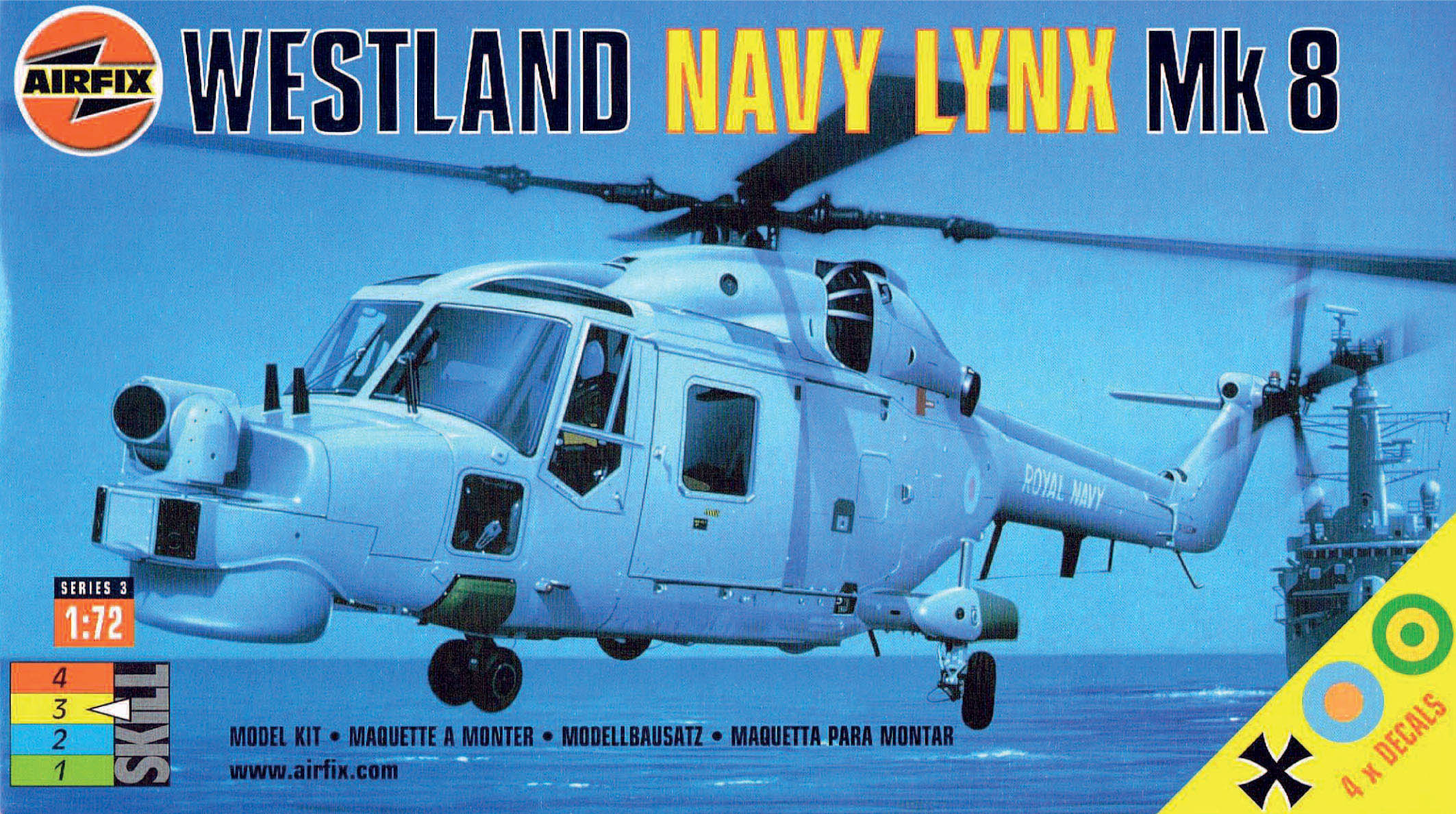
Naval Lynx artwork by Gavin McLeod.
I have been fortunate to examine, close up, all the surviving original artwork for the period from 1982 to 2006. Gavin’s artwork, when viewed at life-size (often roughly 3 × 2ft), is simply stunning. The colours are vivid and of course the airbrush imparts a smooth finish. There is less emphasis on panel lines and rivets, but these don’t really matter when the picture is reduced to box-top size. Detailed backgrounds did not feature on much of the post-1981 artwork, and this is true of much of Gavin’s work.

Gavin McLeod’s reworking of Geoff Hunt’s painting of HMS King George V.
In addition to aircraft he also painted the box tops for the OO/HO Modern NATO Troops and Ground Crew, and altogether he painted around 140 box tops for Airfix, making him probably the second most prolific artist for Airfix. His tour de force, though, must be his exquisite paintings of the 1:24 cars released by Airfix in the 1990s. He brought his airbrushing talent to bear on most of the range of modern and older cars, including the four ‘hi-tech’ cars released in 1991. For these paintings the background was non-existent, as the whole painting was of the car. They were perfectly proportioned and the airbrush gave an almost photo-like finish. Most of the cars were painted by him, but the three Scania Eurotruck and Trailer kits released in 1992 and some of the modern performance cars were painted by Allan Croft.
After Gavin’s death in 2003, Humbrol employed the talents of artist John D. Jones.
John D. Jones
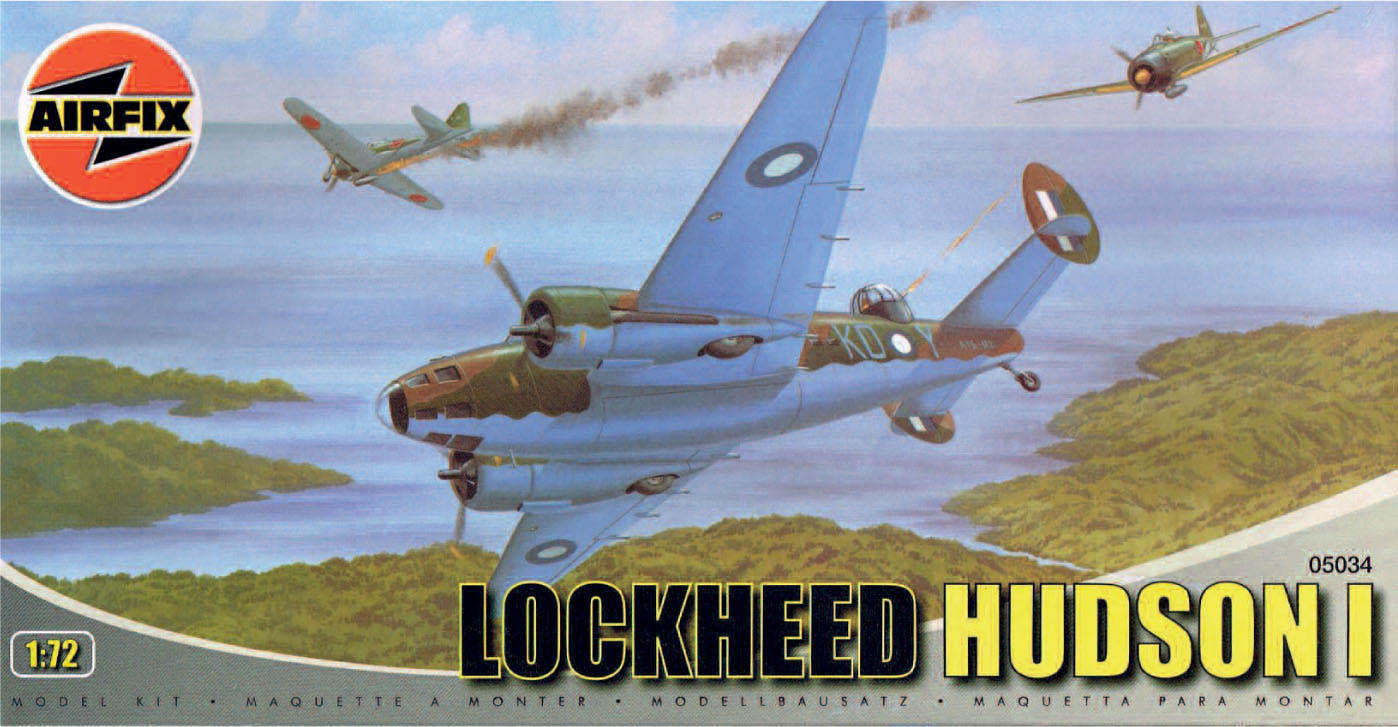
John D. Jones’ Lockheed Hudson artwork.
John D. Jones, known as Dave Jones, took over from Gavin McLeod as the principal Airfix artist. After a dozen years of largely airbrushed artwork, his style returned to painting by brush. He painted some of the new, modified AFV releases, and following the Hornby takeover, did several of the new kit releases, notably the four Canberra bomber kits in 1:48 scale. Most of the re-released and modified aircraft kits put out by Humbrol from 2004 onwards were the work of John D. Jones.
The decision by Hornby to utilize the digital artwork of Adam Tooby (see biographical note below) for its future releases brought to an end Dave Jones’ time at Airfix.
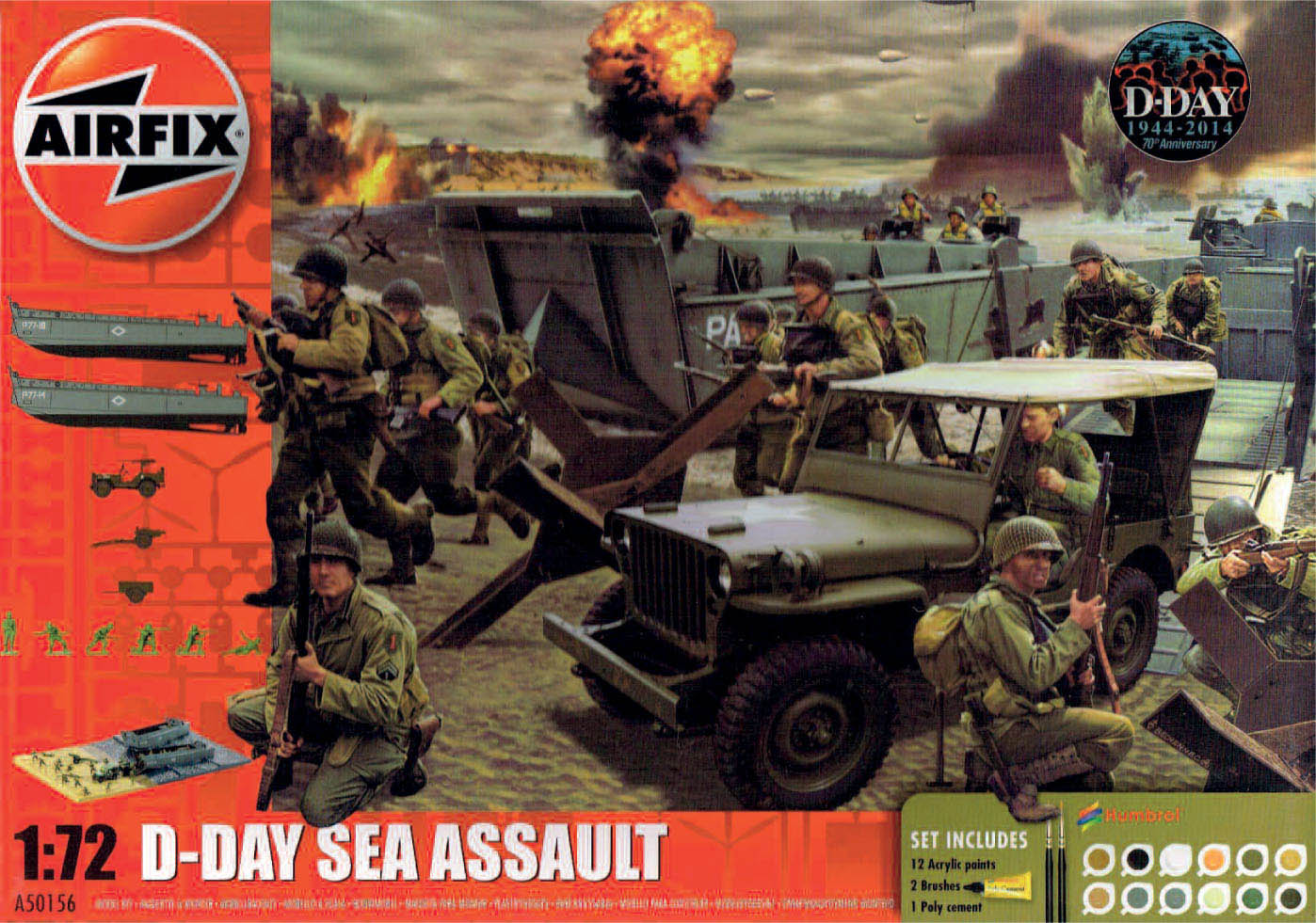
Daniel Bechennec’s D-Day Sea Assault Set artwork.
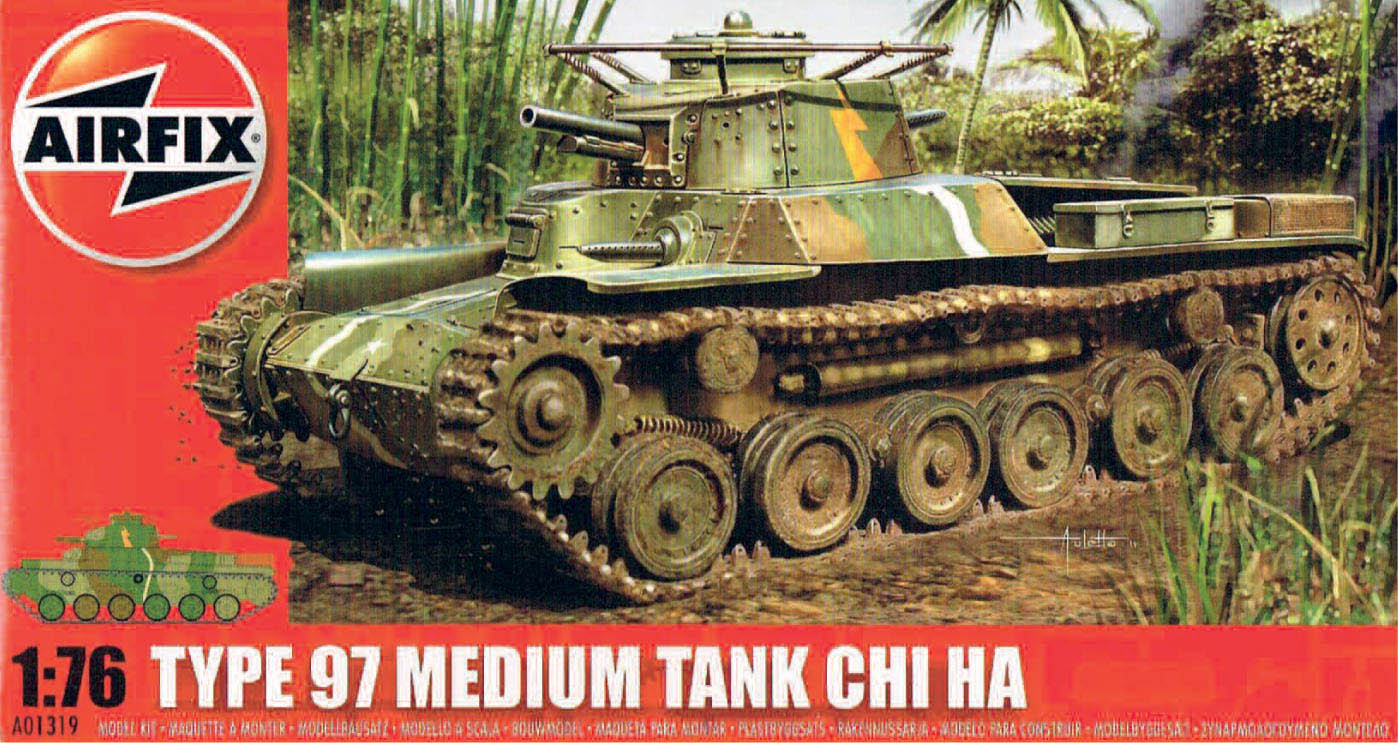
Chi-Ha Tank artwork by Vincenzo Auletta.
Two artists working for Heller before 2006 and who would be utilized by Hornby, were Daniel Bechennec and Vincenzo Auletta.
Daniel Bechennec painted many of the World War II boxed sets, and also the new OO/HO World War II British Infantry. His figure paintings were almost photographic in their appearance. He recently painted the 2014 D-Day sets.
Vincenzo Auletta painted the new AFV kits and the four Hobbycraft Gift Sets in 2010. He also painted the box top for the first World War I Trench Set.
Hornby had embarked on an ambitious programme of new kit releases, many of them replacing the old and ‘tired’ tools in use since the 1950s. Adam Tooby was contracted to produce the digital box tops for these new Airfix kits. Hornby initially released several ‘polybagged’ kits from other manufacturers to bolster the range in the first few years. The AFV moulds of JB Models were also acquired by Hornby for release in their initial catalogues. To illustrate these releases, Airfix called on two new artists: Mike Trim and Keith Woodcock.
Mike Trim
Following the takeover of Airfix in late 2006, Hornby, like Humbrol before, was keen to get the basic range back into production. Until the new kits designed by Hornby reached the shops, several kits were ‘polybagged’ in from other manufacturers, and the moulds of JB Models were purchased. To illustrate these kits several artists were taken on to assist John D. Jones. One was Mike Trim, who wrote the following article for Constant Scale No. 54 in August 2014. He tells us of his brief time at Airfix and, more interestingly, he reveals some of the history of Airfix’s involvement in the television sci-fi programmes of the 1960s and 1970s that we all watched in our childhood. I for one will play ‘spot the Airfix part’ next time I watch a programme such as Thunderbirds!
In 1964, having just left art college and uncertain of what came next, my attention was drawn to a small and ordinary-looking advertisement in Dad’s evening paper. It simply stated ‘Film Company Requires Model Maker’, and having always enjoyed making models, I contacted them and secured an interview. I had no idea who these people were or what kind of films they made, but two weeks later found myself outside a very modest industrial unit on the Slough Trading Estate which bore the legend ‘A. P. Films’ above the door.
The company was run by a man called Gerry Anderson, and their production, Fireball XL5, was then being screened on television. Whilst there I was given a sneak preview of their new product, Stingray, which, unlike its predecessor, was in colour rather than black and white. It looked very impressive, but the real eye-opener lay in the models used to film it. It was immediately obvious that one of the key components in their construction was the extensive use of plastic kit parts to dress the models, which, along with all the added weathering and so on, created a fairly realistic appearance. This was my kind of model making.
I had made my very first kit, an Airfix Fokker Triplane, when I was eleven, and there then followed a long line of mainly Airfix kits. However, after a while I also began coming up with my own creations using pieces from several different kits to produce something a bit different – and what I was looking at that day at A. P. Films was exactly the same process. A few weeks later I started work there doing just that on their latest project, Thunderbirds.
This production, like those that followed, made extensive use of Airfix products, and we regularly received very large boxes filled with girder bridges, footbridges, signal gantries, level crossings and water towers, amongst others. Anyone watching the Thunderbirds launch sequence cannot fail to have noticed the very obvious use of the girder bridge, in particular. In time this range increased, and kits such as the early hovercraft, Old Bill Bus, the vintage Dennis Fire Engine, Saturn rockets and the B-29 were added, all of which yielded many useful parts with which to dress our models. Nothing went to waste, even the kit’s sprue being used for piping on things such as atomic power stations or oil refineries. Right through Thunderbirds, Captain Scarlet, Joe 90 and in the live-action series UFO, Airfix remained a major component in our model-making strategy, despite also using kits from Revell, Aurora and Tamiya.
In 1971 our company sadly closed its doors for the last time, and I, like many others, found myself contemplating moving elsewhere. However, with the British film industry in the doldrums, people began drifting into other unrelated areas. For me, Imoved into illustration andwent freelance two years later, where most of my work concerned aviation or marine subjects. Perhaps the piece most remembered is the cover for Jeff Wayne’s 1977 album, The War of the Worlds. Here my love of ships was combined with a welcome return to the role of designer, my main occupation in the latter Anderson years, as I had to design the various Martian machines as well as produce the cover artwork.
In more recent years, after leaving teaching, I worked on several sci-fi projects, designing and model making, and once again found myself extensively using reissued kit parts made from old Airfix Trackside accessories moulds.
My recent association with Airfix as one of their box-top artists was a highly enjoyable opportunity, but sadly not a particularly long one. It had begun when a friend of mine, who was one of my first students many years ago and had worked at Hornby’s in Margate, and was now freelancing with them, alerted me to the fact that there might be some illustration work required by Airfix. I obviously jumped at the chance, but the advent of digital artwork and the comparative cost of conventional artwork, coupled with the company cutting back its reissues, all too soon brought it to an end.
I had found the redesigned packaging limiting in terms of choosing not only a good view of the subject, but also one that fitted the new format. Given that both ships and rockets are, by their very nature, long thin shapes, the use of narrow boxes, and the inclusion of so much information on them, resulted in much of what one painted being omitted in the final product. Nevertheless, to have found myself painting Airfix box tops somehow seemed a fitting conclusion tomy journey with that company from that eleven-year-old boy, all those years ago, excitedly assembling his first kit. Now retired, it is unlikely that I shall ever be making models again. But if I did, I’m pretty sure Airfix kits would be involved somehow.
Formore information Mike Trim’s website is www.miketrimart.com
The paintings he did for Airfix since 2007 consist of the Wellington Mk Ic/ Mk III, HMS Victory, Golden Hind, HMS Warspite, HMS Iron Duke, HNo MS St Albans, HMS Montgomery, RMS Titanic (1:700); also Vostok, Saturn 1B, Saturn V Skylab, Saturn V, Space Shuttle and ‘One Small Step for Man’.
Keith Woodcock
Another artist who joined Airfix briefly in the period after the Hornby acquisition was Keith Woodcock. He painted all the ex-JB Model kits for their 2008 release, although today only three survive in the Hornby range. One, the Vickers Light Tank, has been repainted by Vincenzo Auletta to match his other AFVs, although the two Land Rovers were simply modified. His last painting for Airfix was of the Churchill Bridge Layer, but Airfix had decided to go for digital artwork so it was not used. In Constant Scale No. 55 in late 2014, Keith wrote this interesting account of his time at Airfix:
My initial contact with Airfix was via Trevor Snowden, whom I had known for some time through my occasional leisure activity of plastic modelling. As he lived fairly close by, although separated by the River Humber, it was very convenient for both of us to meet up and discuss the projects and for him to collect the artwork instead of having to risk the postal services.
Apparently Airfix had just taken over another kit manufacturer, JD, and their box art was in need of revamping and bringing up to the standard of other kits in the Airfix range. However, at that time there was a shortage of available artists who undertook this type of work, so Trevor contacted me to ask if I would be interested, and I agreed to work on the project. As many of my paintings are commissioned with no deadline I could slot these new items between those I already had in progress. They were a little outside my normal sphere of activity, and I don’t pretend to be very knowledgeable on such military subjects, but I was given more than adequate information and photographs, together with test shots of the actual kits. I found the latter to be invaluable for ensuring I was painting the actual subject in the box and not a variation!
Half-tone pencil sketches were completed (see attached), then coloured up and submitted for approval, these having to fit the standard kit box format. Once approved, I completed the artworks using my normal method of gouache on heavy watercolour paper, as this produces a very flat surface ideal for reproduction, as opposed to oil on canvas where the weave can show through. I didn’t sign any of the paintings as this would intrude on any cropping of the image which might be necessary when planning the descriptive wording on the box.
The last subject I painted was the Churchill Bridge Layer, and I have attached the original pencil sketch for this, roughly showing the possible locations for the logo and title. Around this time I had a call from Trevor to say that there had been a management meeting at which it had been decided that all future artwork would be digitally produced and that there would be no further painted work commissioned.
I had quite enjoyed my short time of working with Airfix, despite the subjects being outside my usual range of aviation and motoring subjects. It is also satisfying to walk into a model shop and see one’s paintings adorning the kit boxes. My only regret is that I was not allowed to keep the artwork, apparently a company policy but quite different from many other publishers. I believe these paintings may have been auctioned or sold off at some time, as a few of their new owners have contacted me to confirm that I was the artist.
Like Mike Trim and John D. Jones, he was to find that the move to digital artwork would bring to an end his painting for Airfix. This decision was largely inspired by Adam Tooby, who had showed his digital artwork to Hornby, when it was decided to use digital from then on.
Adam Tooby
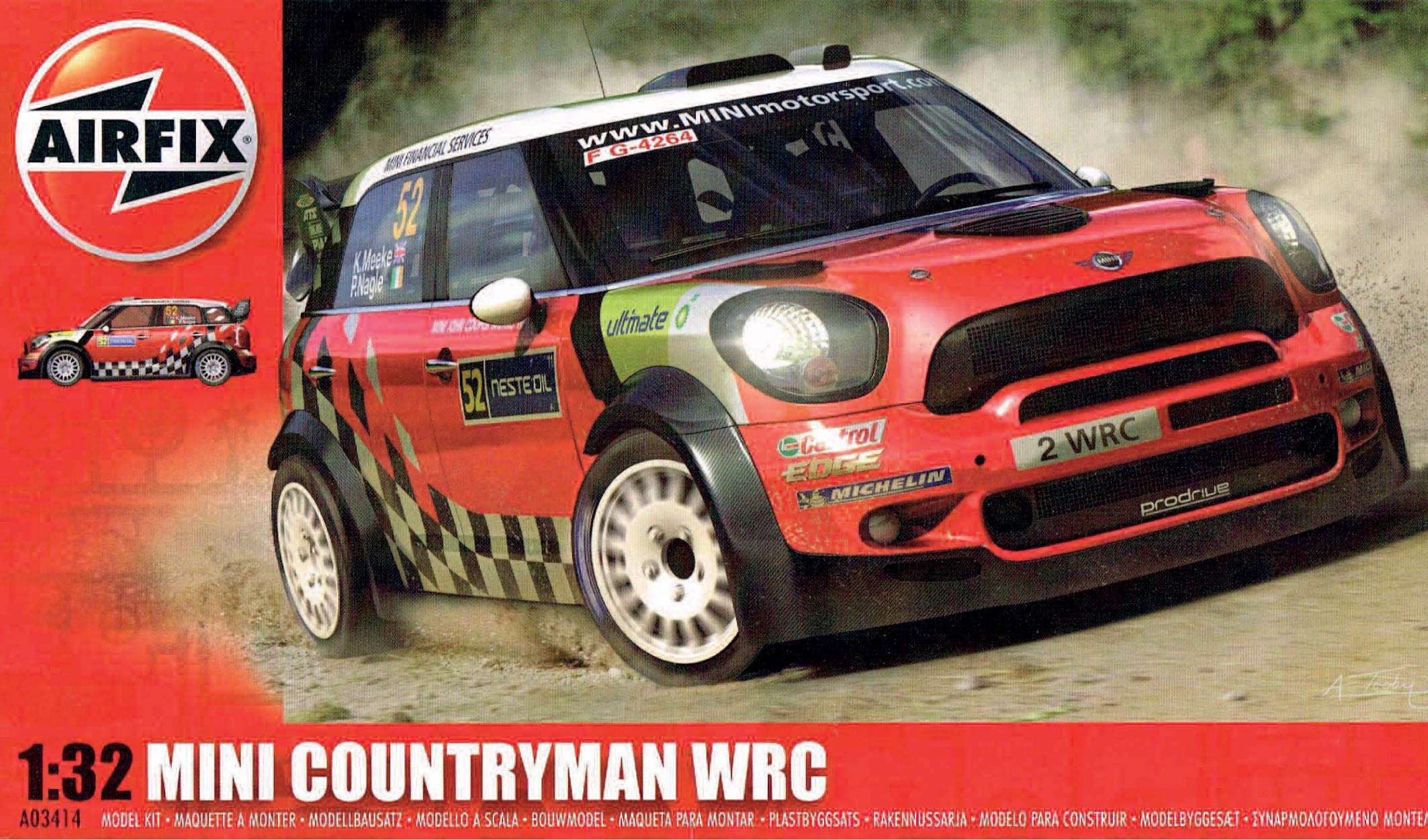
Adam Tooby’s Mini Countryman WRC car artwork.
I suppose the artist who has had the biggest influence on Airfix box tops since Roy Cross is Adam Tooby. He introduced digital artwork to Airfix, and it was quickly decided that that was the way to go for the new releases, which were predominantly aircraft. The first hint of a move towards this type of artwork was the advertisement for the 1:48 TSR2, which was totally different from the other artwork Airfix was using.
The big advantage of digital artwork is that the pictures are made up of layers, so it is possible to move around objects in the background. Some of the adverts for a new aircraft feature other aircraft in the background in different positions, and this gives a flexibility not possible with a standard painting. Also the resulting painting has a ‘photo realism’ that few brush painters manage to achieve.
Adam currently illustrates all the new aircraft releases, and his box tops, such as the stunning 1:24 Typhoon, are rapidly creating a sizable following of adherents. It is fair to say that his digital artwork, when used with the new Type 16 box design, is largely responsible for letting modellers know that Airfix is back!
Other Digital Artists
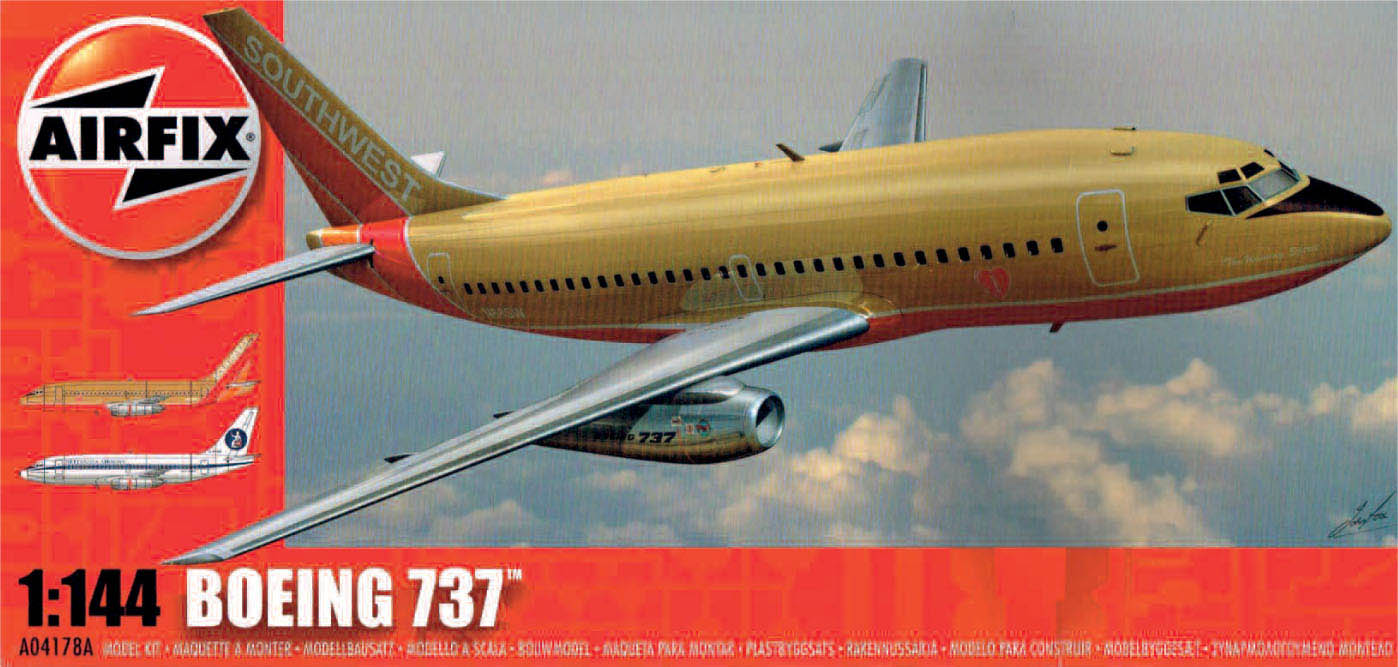
Boeing 737-200 artwork by John Fox.
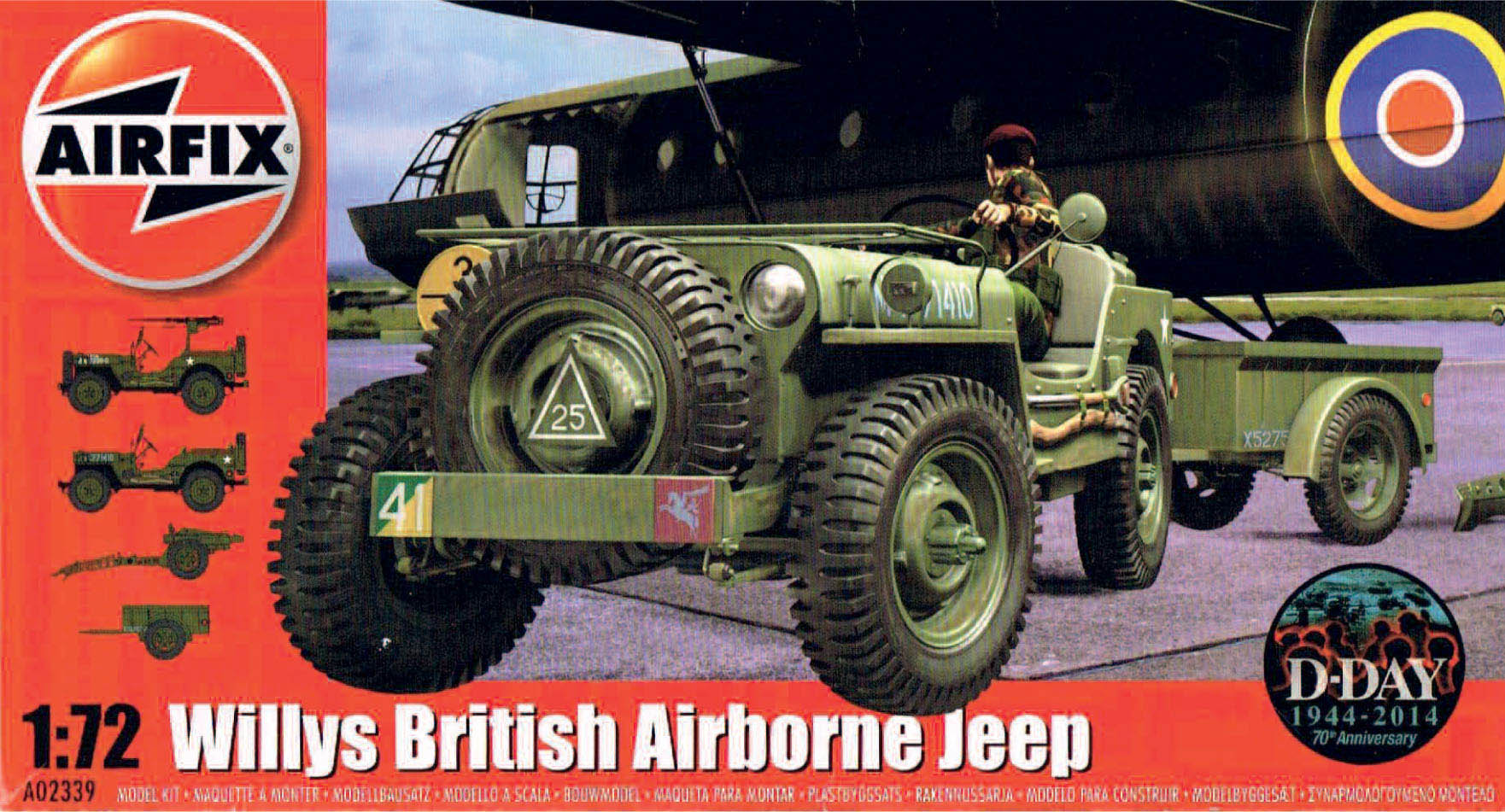
John Fox’s Willys British Airborne Jeep artwork.
With the increased number of new tools being released by Airfix, Adam Too by was being kept fully occupied, so it was decided to have some of the re-releases painted by another artist. John Fox was chosen to paint the Matilda Hedgehog, and later the Dinah and the second re-releases of the Boeing 737 and 727. Several of the 2014 re-releases are the work of John Fox. His style is similar to Adam’s, but the trained eye can tell the difference.

Jon Plumb’s Sea Hurricane Mk IIc artwork.
Another digital artist who painted for Airfix around 2009 to 2010 was Jon Plumb. He painted all the small pictures on the back of the 1:24 Mosquito, as well as the box tops for the MiG-15 and Sea Hurricane Mk IIc.
In Summary
Airfix has now stopped using conventional painting in favour of digital and now employs digital artists for its AFV and car kits. Just as the new CAD process has rejuvenated the actual kits, digital artwork has brought about a renaissance to the appearance of the range of kits.